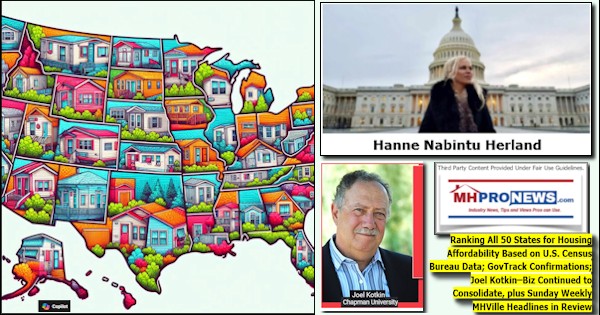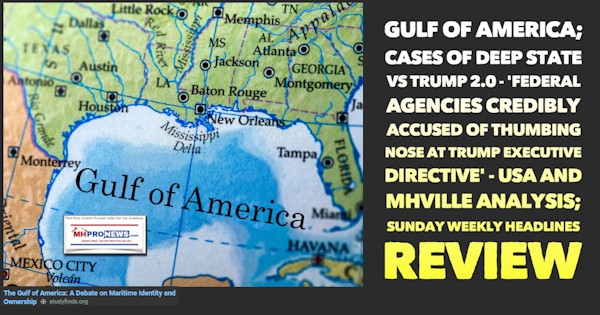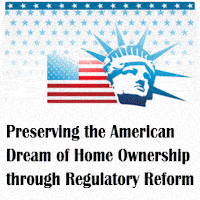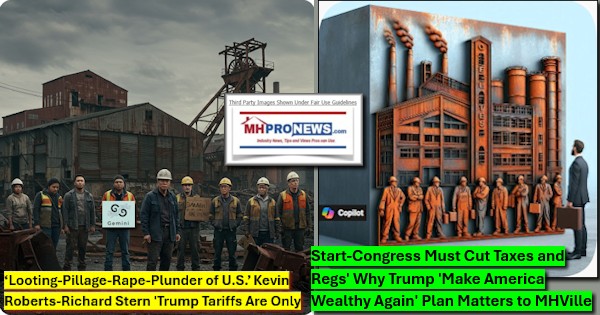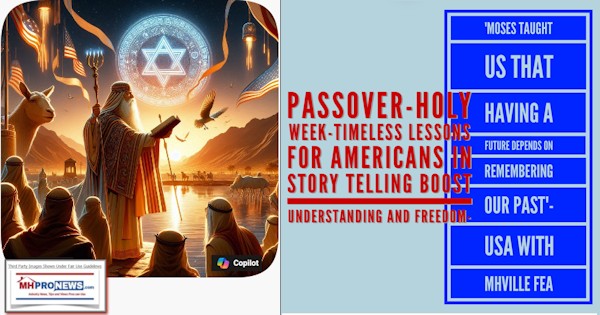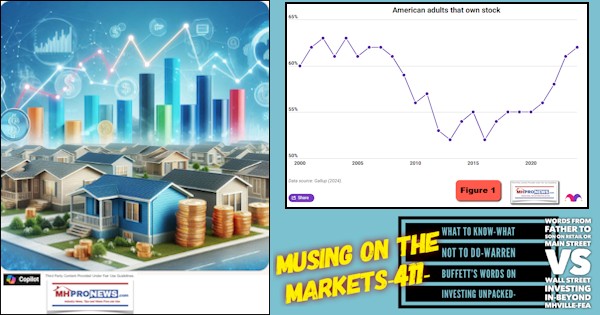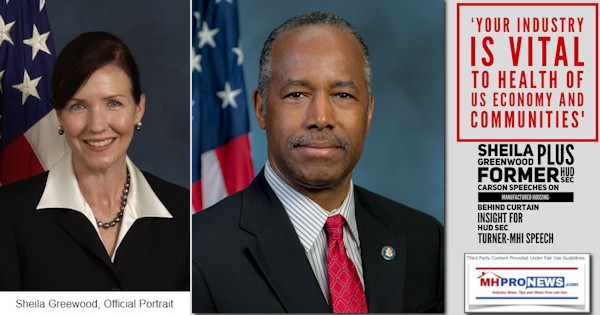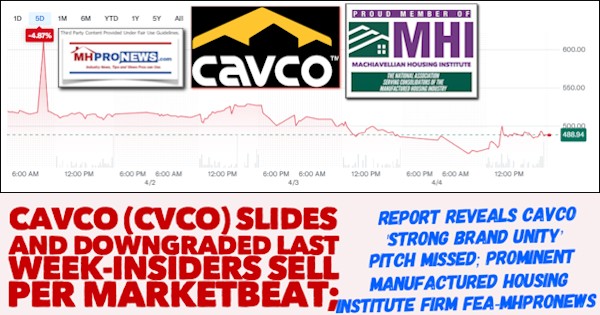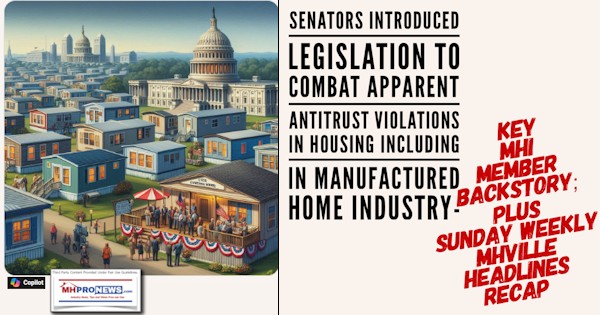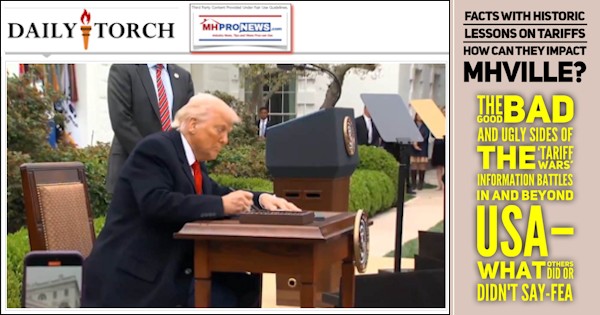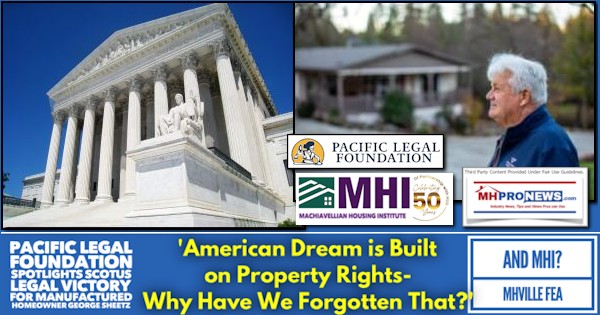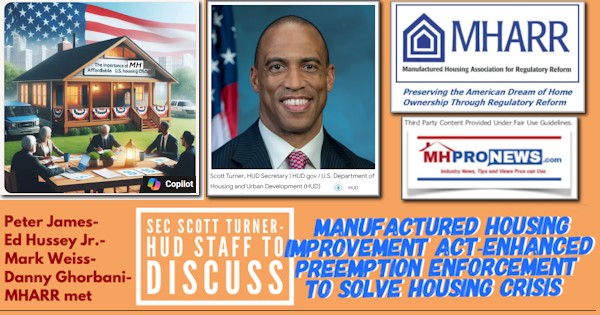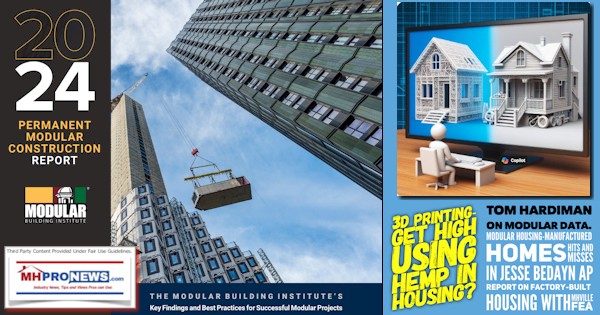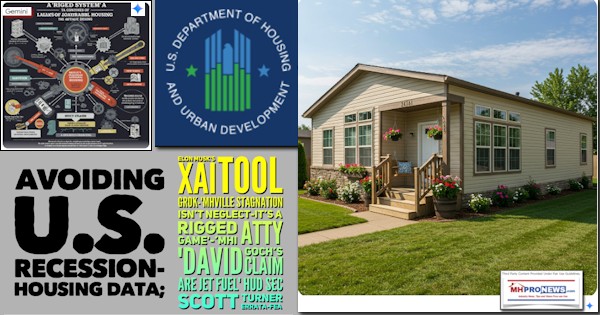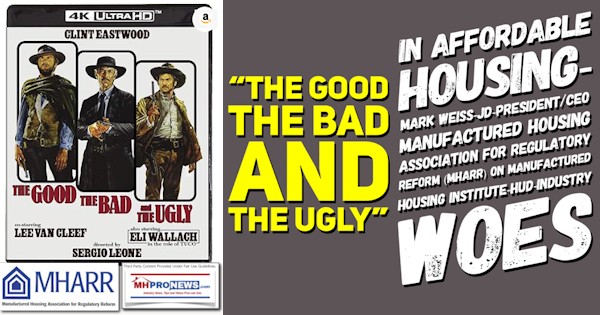
Remarks from legal professional and zoning expert Daniel R. Mandelker, J.D., help frame the more detail insights that follow from Harry J. Abramson. MHProNews and MHLivingNews previously reported remarks by pro-manufactured housing zoning law expert and land use professor Mandelker who said: ‘Statutes Should Prohibit Restrictive Zoning Standards for Manufactured Homes’ and added that an ‘Organization is Needed for Manufactured Housing Advocates Litigation and Legislative Support.’ Without naming the Manufactured Housing Institute (a.k.a.: MHI or “the Institute”), it was an apparent backhanded slap in their faces by a notable zoning law expert. Mandelker knows about Berkshire Hathaway (BRK) owned Clayton Homes because they were referenced in his article, so one might think he knows about the trade group (i.e.: MHI) that Clayton helps run (or dominate). More facts-evidence-analysis (FEA) will follow in Part II.
Do not miss the ‘deep research’ by Gemini into this article, its linked items, and related. This is a deeper dive than normal even for facts-evidence-analysis (FEA) heavy MHProNews. Grab your favorite beverage or snack for the time of day you are reading this and then dive in.
But first, who is Abramson?
Abramson authored “The purpose of trade associations is to promote, protect and improve our function!” Has manufactured housing industry function and performance improved in the 21st century vs. the late 1990s? That is one of several acid tests based on key performance indicators instead of behavior that amounts to flashy razzle dazzle or gaslighting.
While Abramson wasn’t talking about MHI, that is precisely what makes his insights about a good trade association useful. How so? Because several of the points that a good trade association should do or not do were raised by Abramson. Principles he raised could view some behavior apparently at work at MHI as de facto indictments of “cronyism,” “Domineering Factions,” “image building, or other problematic behavior at the Institute. See Abramson’s text provided in Part I below linked here, here, and here.
About Harry Abramson, according to Bing’s AI powered Copilot to MHProNews. Bold was added by MHProNews for emphasis.
Harry J. Abramson, the president of Electronic Salesmasters Inc., wrote the article The Perfect Trade Association in the Eyes of a Rep to explore and define the ideal characteristics of a trade association. He emphasized the importance of trade associations in promoting, protecting, and improving the functions of their respective industries. Abramson highlighted his positive experiences with organizations like MANA (Manufacturers’ Agents National Association) and ERA (Electronics Representatives Association), which he credited with enhancing his business acumen and providing valuable networking opportunities.
The article was likely written as a reflection of Abramson’s extensive involvement in trade associations over his career. He has been an active member of several associations for nearly 40 years, contributing through leadership roles, articles, and speaking engagements. Abramson’s dedication to the industry earned him recognition, including the prestigious ERA Lifetime Achievement Award.
From their website.
“I am privileged and honored to present my father, friend and mentor Harry Abramson with the Electronics Representatives Association [ERA] Lifetime Achievement Award,” said – Spencer Abramson, President of Electronic Salesmasters, Inc. “The mission of the ERA is to advance and support professional field sales in the global electronics industry by providing programs, services and activities that educate, inform and advocate for manufacturer’s representatives, the principals they represent and the distributors who are representatives’ partners in the marketplace.”
Harry J. Abramson and “his MANA-member organization is recognized as one of the leading passive component representatives in the Ohio, Western Pennsylvania and Michigan marketplace. He is the past president of the Ohio Chapter of ERA and vice president of the Passive Components Group.” In that world, Harry J. Abramson is a respected and accomplished figure. Per ERA.
He [Harry J. Abramson] established industry notoriety by virtue of his firm’s peak performance, hundreds of articles and speaking appearances at ERA’s national conferences and chapter meetings and sister trade association MANA.
So, there are apparent reasons why he and his insights on trade groups should be valued.
While Abramson was writing for an audience of electronic sales reps, for the purposes of this MHVille article, his thoughts could also be construed as what an umbrella style trade association should look and operating like.
Specifically think the Manufactured Housing Institute (MHI), which claims to represent “all segments” of the manufactured home industry.
While Abramson’s text is as provided in the PDFs linked above, save for some spacing or typo glitch fixes (e.g.: “annointed” is changed to “anointed”), imagine that terms like MANA, ERA and COSE said “Manufactured Housing Institute” or “MHI” instead. Doing so could be eye opening and potentially profitable. More on that along with more manufactured housing industry insights on what makes a good trade group are in Part II.
MHProNews has recalled the insight from a manufactured housing industry state association executive that a good trade group is focused on 3 things. Protect. Educate. Promote. Or P.E.P. for short. Harry J. Abramson wrote: “PROMOTE, PROTECT AND IMPROVE” is what he thinks are the keys. He goes into details, as the following will reflect.
Part I – Article by Harry J. Abramson
1) The purpose of trade associations is to promote, protect and improve our function!
The Perfect Trade Association in the Eyes of a Rep
Despite a weak economy, we are all proud to be gainfully employed by reputable companies in viable industries. Numerous market segments have trade associations and I have been a proud member of MANA, ERA and COSE (Council of Small Enterprises). The purpose of this article is to explore and define the perfect trade association, and I believe MANA is the most perfect. I trust that your MANA experience is as positive as mine and that your association has helped you become more profitable and a better businessperson.
Trade associations are a viable and inherent part of almost every industry and they were created for a perfectly good reason – to create and foster a spirit of mutual respect among the members of the association and other groups such as principals, distributors, customers and individuals within the industry. A trade association’s primary mission is to educate their industry to the economic advantages and benefits of doing business with groups such as representatives, distributors and manufacturers.
The perfect trade association avails the opportunity of continued growth through educational programs and networking. Most trade associations are efficient organizations that provide tools, knowledge and real value. Like everything else in our business life, some trade associations are better than others and, just like any other business, some are more financially sound than others, and the same applies to leadership. Due to a weak economy and business pressure, many associations are feeling the pinch of dwindling membership causing financial pressure – thank goodness MANA is an exception.
Why Join
For almost 40 years I’ve been an active member of several trade associations. Why? Simply because they’ve made me a better businessman, educated my staff and provided cost-effective benefits that I normally would not have. So why doesn’t everyone join – good question! Here are some issues and answers:
- Too Busy: No one is ever too busy to learn new things and make new friends. 2. Too Costly: MANA is a bargain at any price and the dues are very reasonable.
- Not Learning: Those not benefiting from the programs are often not expressing their needs.
- It’s for “Owners Only”: Wrong! Good programming is for everyone. Today’s staffers are tomorrow’s successors.
- Inconvenient Location: While venues ideally have easy access, keep in mind that some of your customers are in the boondocks, yet you call on them.
A common thread among many trade associations is that it is becoming more challenging to attract new members while keeping programs fresh and viable. Accordingly, perfect association leadership like Joe Miller practices is always open to fresh ideas.
United We Stand
United we stand means the same as “group unity” and the perfect associations have strong leadership that promote a unified front to achieve fair solutions of difficult issues, such as arbitrary commission rate cuts, house accounts, one-sided contracts and split commission tracking. I’m not talking unionism or collective bargaining, but simply good faith and fair dealing. It’s the real basic stuff – “Do unto others . . . ” You know the rest. The perfect rep trade association also promotes the concept of a commitment to the cost-effective, outsourced sales function and not just “renting a rep” during a rough economy. Today’s professional sales representative is a bargain in any economic climate.
Networking
Networking is a great reason that we join trade associations. Fellow members develop friendships and share creative ideas that help one another.
Topics like how to motivate and compensate are great examples. Improving
efficiency and productivity are also two of the critical benefits derived from networking. Unique and improved selling techniques are shared by networkers and this was how I was introduced to Jack Berman’s famous “Call Organizer” – that alone was, a major discovery.
Education
The perfect trade association educates their members to become better businessmen and gain more knowledge of their industry. They conduct seminars on a local and regional basis. Some have annual conferences. They don’t stop at educating just representatives. They also inform manufacturers of the needs of representatives as well as their expenses. The perfect trade association educates principals to the fact that their representatives do not simply put the commissions in their pockets, but pay for an expensive support staff (infrastructure) and all of the hardware, software, training, legal fees accounting fees, fringe benefits. health insurance, automobiles, car insurance, T&E and – least to mention retirement. They also promote the concept that principals and their representatives work best together when they collaborate and are “partners in profit.” This is what I consider to be “critical knowledge.” Also, many associations provide statistical data to help us make decisions.
…
Conferences & Seminars
Education is critically important to the perfect trade association. To that point, it does not recycle the same material year after year. Programs are refreshed in order to keep members learning and growing. Conferences provide members with a chance to meet and hear industry leaders and glean important information regarding trends in the marketplace. Conference costs are kept as reasonable as possible to make attendance affordable for everyone.
Leadership
Leadership is entrusted with the responsibility of promoting the association’s values and a positive image. The perfect leader may be a high or low profile guy, but who cares as long as he gets the job done. Perfect leaders are facilitators and have great vision and management skills. They are mindful of what is best for all of their members just like a politician is of their constituency. But your association leader need not be a politician. Ideally he is a perfect leader, manager and people person. We are privileged to have one, and he is worth his weight in gold. MANA is fortunate to have an exceptional leader – they are a rare breed.
Financial Responsibility
The perfect trade association is financially stable and manages its money wisely. It establishes a budget and lives by it. Frivolous expenditures have no place in nonprofit trade associations and neither do lavish fringes or golden parachutes for their executives. When money is tight, they resourcefully find ways to generate revenue and don’t simply increase membership dues. Often this is accomplished by fee paid educational programs, advertising in association publications, selling associate memberships and group discounted services such as insurance, communications, software and a myriad of other things. Another possibility is sponsoring tradeshows, but it has its pitfalls in a soft economy.
The perfect trade association, like MANA, is run like any other well-managed business. Salaries are reasonable and in line with other comparable associations. Budgets are established and there are no unnecessary expenses. In some cases trade associations have offered memberships to manufacturers. This has helped to improve cash flow, but hopefully has not compromised the single-minded purpose of the association
– To PROMOTE, PROTECT AND IMPROVE THE REP FUNCTION.
Cronyism
Perfect trade associations are not viewed as fraternities or “good old boys” clubs and are void of cronyism. Officers and board members are elected, not hand selected, appointed or anointed. There is no room for showcasing or self-aggrandizing. Perfect trade associations are democratic, not autocratic. Ideally, members see each other as peers or friends, not cronies. Mutual respect prevails, not criticism or denigration. The perfect association member expresses any dissatisfaction thru the appropriate channels. If that doesn’t work, he gets involved by becoming actively engaged at the chapter or national level. If he does neither of these things, some might view him as a perfect malcontent.
Domineering Factions
Large firms do not constitute an elitist group within a perfect association. All member firms have an equal say and an equal vote. Larger does not mean louder or smarter. In fact, many smaller firms often outperform larger ones where it counts – the bottom line. There are no “hot lines” or special considerations for “friends of leadership.” Simply put, there is no such thing as “insiders.”
Image Building
Some trade associations paint a picture that their membership consists of an elitist group of high performers. If you said, “That’s pure folly!” – I agree. However, their members belong for numerous other benefits, and that’s a good thing. Part of the association “image building” is promoting themselves on an Internet web site – sort of a community affair. This listing (advertising) is fee based and an excellent revenue builder. However, the perfect trade association is mindful that the pursuit of revenue can lead to the needs of membership being forgotten. Ideally, a balance is present.
Membership and Dues
The perfect trade association, like MANA, has a reasonable dues structure, which is consistent with the value that it offers.
There is no doubt that some are feeling the “membership pinch.” If this is the case, they may have to make adjustments, just like their member firms. this may include staff and/or salary reductions. Worse case, they may even consider “trade association contraction.” This means that similar associations would merge and ultimately realize economy of scale. The new group may refer to themselves as an “alliance” under one overarching governing body.
Contraction is taking place in the world of repping and distribution – why not with associations?
Oneness
The perfect trade association has members that belong both at the national and chapter level. They are not fragmented and everyone has the same vested interest both locally and nationally. Different types of membership may suggest different interest levels. The perfect trade association fosters uniform interest and participation among all its members. Special venues are reserved for industry specific interest groups. Incidentally, chapter membership provides us with the opportunity to break bread with our competitor (I prefer the word “colleague”) and possibly develop a friendship – THIS IS A GOOD THING!
Succession
This is a “no-brainer!” Succession and success are synonymous in a perfect trade association. It is no different than a well-managed corporation. Succession is part of the perfect business plan. If there are no successors in your trade association, it may be justification for a merger or contraction. Ideally there is a “built-in successor” who is precisely the same kind of person you would have hired to run the show in the first place. In a perfect world, he’ll be better than his predecessor.
Mission Statement
The perfect trade association has a mission statement that is more than just rhetoric. It is updated with the times and revisited annually. If it isn’t – forget it. The mission of perfect associations is clear and obvious with or without a statement. One of the less visible missions of associations is to provide its members with governmental lobbying at state and federal levels. Reps by the nature of their business are small and associations help them present a collective and louder voice. In some cases, associations join together and present themselves as an association of associations for mega clout (hope you’re not confused). AMRA is the Alliance of Manufacturers Representatives Associations.
By-Law Compliance
By-laws, like contracts, are dry and boring reading but are essential in all the trade associations. They are basically the same as “minutes of incorporation” and invariably are fair and equitable, The important thing is that the perfect trade association complies with their own by-laws, which by another name are simply guidelines.”
Elections vs Appointments
Perfect trade associations are the ultimate in democracy and are not headed by autocratic or dictatorial CEO’s or Board of Directors. It is understood many of the incumbent officers may climb the proverbial ladder, but ideally there are always two or more candidates for each post. If leadership perpetuates a “sphere of influence,” it may be counter-productive to the general membership and tend to suppress the interest of aspiring leaders. In fact, they may get frustrated and quit. This does not happen in a perfect trade assocation.
Lines Available
Virtually all manufacturers’ representative associations have a Lines
Available listing. They disseminate this information by fax, e-mail, at tradeshows or have a web site that is password protected for its members. This is a valuable service for both manufacturers and representatives alike. For many members it is worth the price of admission (dues) alone. Is it a perfectly good reason to join? Perhaps! Also, membership directories are often used by manufacturers who are looking for reps.
Code of Ethics
Why is it that virtually every trade association feels compelled to have a code of ethics? They consist of great ideals, but it takes near perfect people and their organizations to comply with them. My compliments to those reps who comply with the ten commandments of repdom. Accolades of praise to those reps who say that they won’t break their association’s code of ethics, especially as it applies to stealing lines. Special kudos to those who won’t even talk to a manufacturer while the line is still under contract with a rep that has not received a termination letter. To me the code of ethics is no different than the golden rule. Ethics in our personal and business lives should be one and the same.
Group Buying
Most trade associations offer group purchasing plans for such things as medical and life insurance. Additionally, they may have discounts on communications plans, car rentals, travel and other products and services. Are they good – very possibly, but many association members have found equivalent or better deals in their own backyard. Unfortunately, this used to be an excellent revenue producer for trade associations, but their diminishment has exacerbated the financial problems of some associations – hopefully not yours. Many associations make available to their members knowledgeable legal and accounting experts. They are rep-savvy guys, who understand what we do better than our spouses.
Summary
Trade associations are like people and companies – neither is perfect. However, they exist for solid reasons. They provide benefits and a collective voice. If they don’t, you may be in the wrong one. If you don’t belong to one – check it out! Ask members what they think. Joining the right association for the right reasons will pay dividends. If you get involved and committed, it is bound to be in your company’s best interest.
You’ll be working with members who share the same goals.
Ideals of a Perfect Trade Association
- To provide educational services
- To foster networking
- To safeguard the integrity of its membership’s profession
- To enhance professionalism
- To be financially stable within itself
- To promote the function and benefits of its membership
- To optimize the value to its members
- To interact with representatives’ principals when appropriate
- To advertise “lines available” and “Reps wanted”
- To establish, promote and support a practical “code of ethics”.
There is strength in numbers and togetherness provides a sense that we can accomplish anything – and we have a lot to accomplish in our great industry! What are you waiting for? You can make a difference today!”
—
Part II – Additional Information with More MHProNews Analysis and Commentary
In no particular order of importance are the following.
1) P.E.P. means Protect-Educate-Promote. As that link reveals, MHProNews has periodically raised the topic of P.E.P. principles as a yardstick for manufactured housing industry trade group performance for years. The item in Part I above by Harry Abramson was discovered by MHProNews after doing a search using that P.E.P. mantra as it applied to umbrella style trade associations.
2) K.P.I. means Key Performance Indicators. While there are several possible key performance indicators (KPIs) in manufactured housing, certainly among them would be the production and shipment totals nationally and by state for HUD Code manufactured homes. Using that KPI, the Manufactured Housing Institute (MHI) is arguably failing the industry in the bulk of the 21st century. See the report linked below for facts-evidence and specifics.
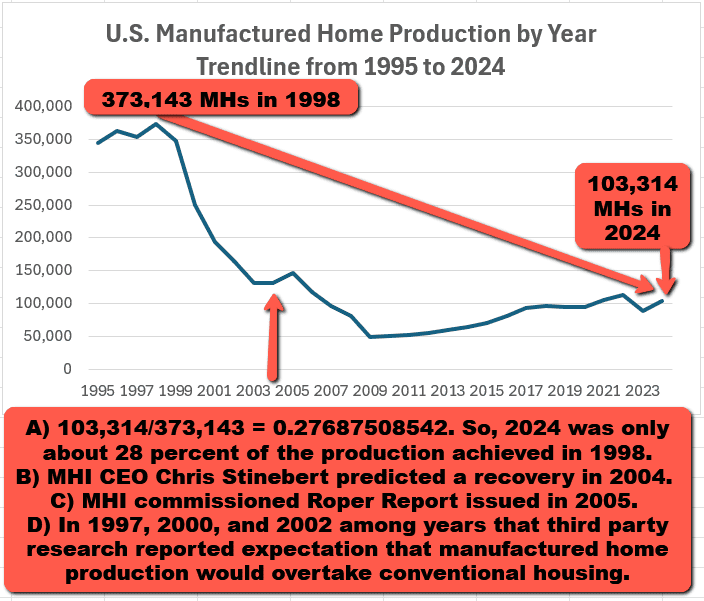
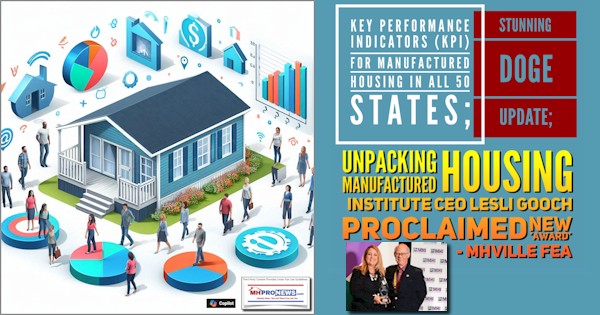
3) Perhaps precisely because Daniel R. Mandelker‘s article wasn’t focused on slamming MHI, yet he said: ‘Statutes Should Prohibit Restrictive Zoning Standards for Manufactured Homes’ adding that a trade ‘Organization is Needed for Manufactured Housing Advocates Litigation and Legislative Support.’ Those remarks ought to shine forth as headline critiques of the Arlington, VA based Manufactured Housing Institute (a.k.a.: MHI or “the Institute”) as made by a notable zoning law professor. As was noted in the preface, those statements by Mandelker are an apparent slap in the face of MHI. Details and context are found in the reports linked below. Professor Mandelker was making an argument for more manufactured housing, so he is “pro-manufactured housing.” He was saying that a key factor missing to achieve growth is the lack of a trade group that is making the legal and lobbying arguments he has stressed to meet the barriers in place.
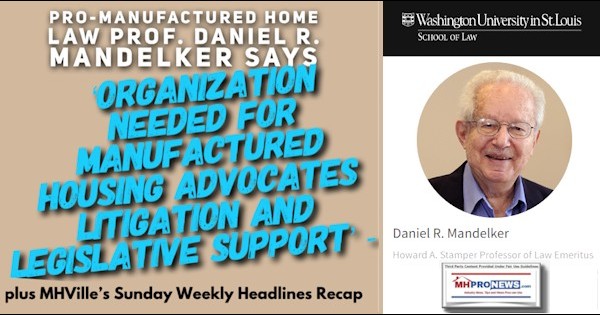
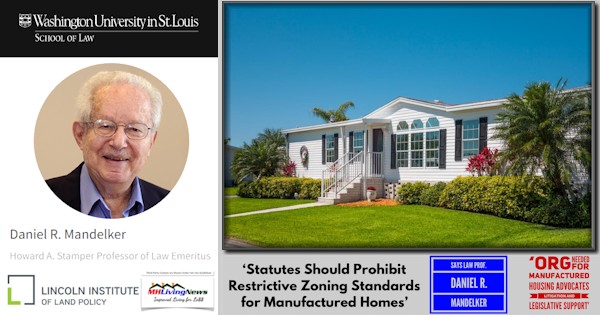
4) Arica Young specifically referenced Mandelker’s insights in her report. See her observations unpacked in the article below. Young is also pro-manufactured housing and is arguing for how to achieve more production.
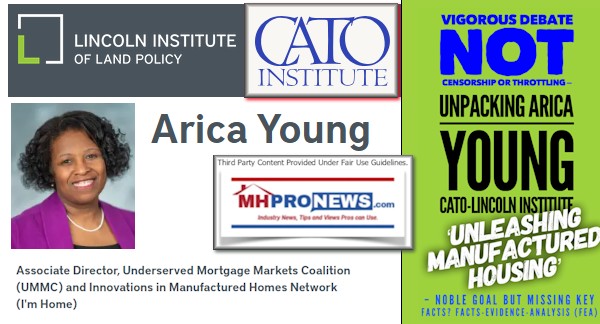
Young and Mandelker are interested and supportive outsider remarks looking into MHVille. More can be provided later, but next, let’s pivot to those within the boundaries of manufactured housing including some who are MHI members.
5) There are insider remarks that directly or indirectly related to the effectiveness (or lack thereof) about the Manufactured Housing Institute, including from members of MHI, including ‘award winning’ members of MHI. A sampling of those follows.

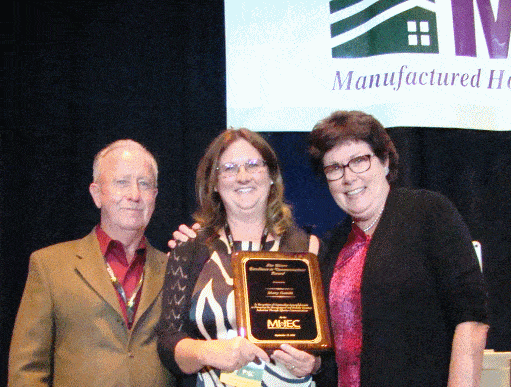
6) While Amy Bliss’ remarks are wagging a proverbial finger at federal, state, and local governments, they are also de facto have the proverbial 3 fingers pointing back at MHI in as much as she would have no complaint if MHI had successfully addressing the issues that she is addressing.

How so? Because you can’t have the one (Bliss calling federal, state, and local governments ‘hypocrites’ by excluding manufactured homes) and not have MHI sharing in some extent in that status quo because those ‘hypocritical’ governments are not being successfully dealt with by them (or her?!). Note that Bliss and the housingalliance.us website makes no mention on its public side of “enhanced preemption” under the “Manufactured Housing Improvement Act” (a.k.a.: MHIA, MHIA 2000, 2000 Reform Law, 2000 Reform Act). See that below her quote graphic.
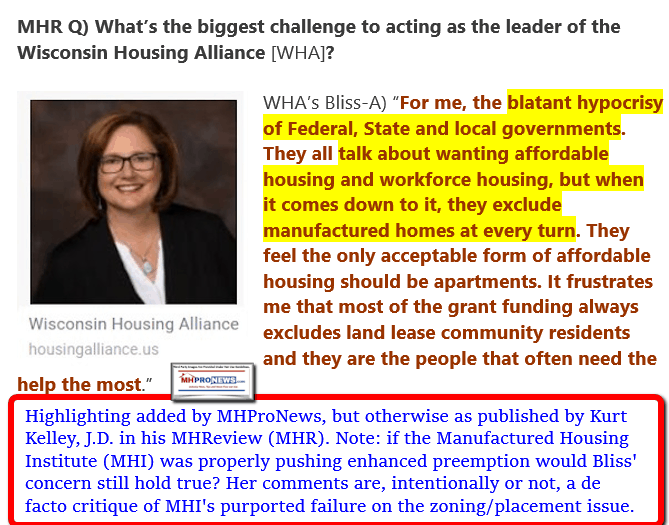
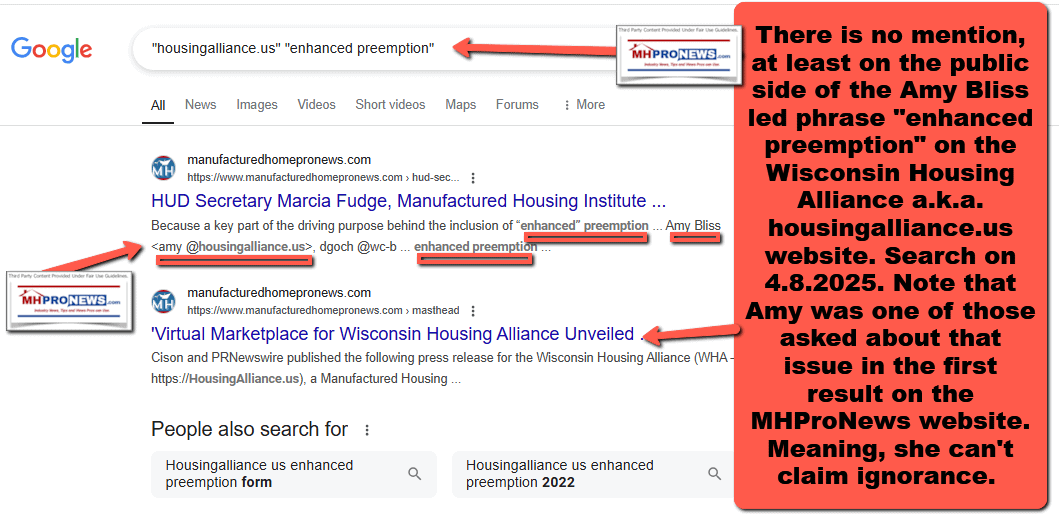
The importance of that phrase “enhanced preemption” is illustrated in at least four ways.
a) First, because Bliss’ colleague, MHI CEO Lesli Gooch herself has used that term: “enhanced preemption.”
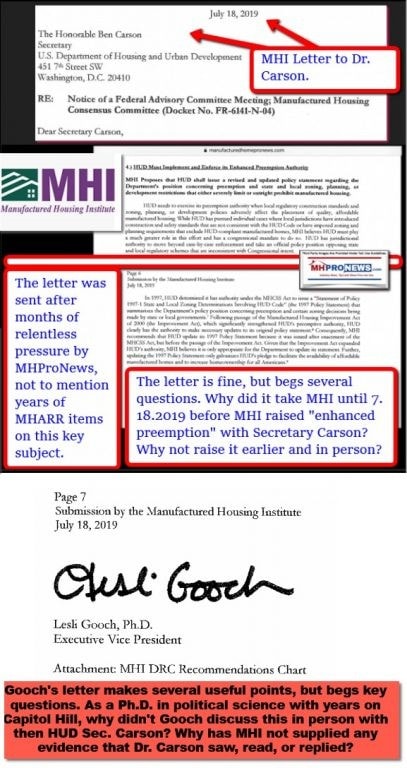
b) Second, and arguably more important than Gooch’s reference, is the point that manufactured housing under the 2000 Reform Law was intended to have enhanced preemption. MHProNews notes that each of those lawmakers were involved in the passage of the MHIA or 2000 Reform Act.
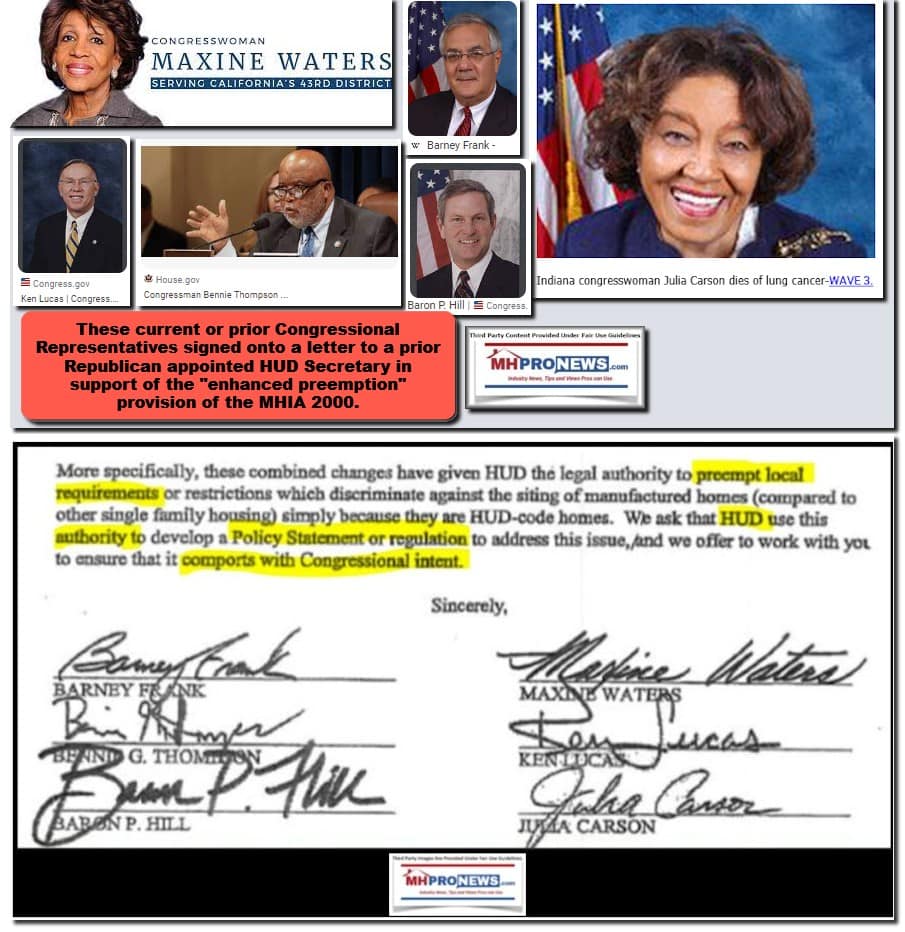
c) From the letter by lawmakers to HUD Secretary Mel Martinez (R) found in the link below that image above are these statements.
HUD should have taken this opportunity to use its expanded legal preemption authority under the 2000 Act to develop a Policy Statement or regulation to make it clear that localities may not engage in discriminatory practices that unfairly inhibit or prohibit development and placement of manufactured housing.
…
New purposes were also introduced by the 2000 Act, which includes protecting the “affordability of manufactured homes,” and “facilitating the availability of affordable manufactured homes and to increase homeownership for all Americans.”
…
…the 2000 Act expressly provides, for the first time, for “Federal preemption,” and states that this should be “broadly and liberally construed” to ensure that local “requirements” do not affect “Federal superintendence of the manufactured housing industry.” Combined with the expansion of the findings and purposes of the Act to include for the first time the “availability of affordable manufactured homes,’
Thus, the term “enhanced preemption.”
The original HUD Code also had federal preemption, but the 2000 Reform law was specifically intended to overcome local zoning barriers that Amy Bliss, Mary Gaiski and others like the Manufactured Housing Association for Regulatory Reform (MHARR) have consistently and persistently pressed for “enhanced preemption” regardless which party was in power in Washington, D.C.
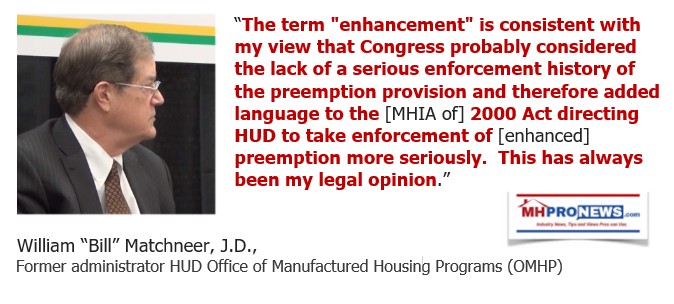
d) But the importance of the principle of how preemption could boost manufactured housing is vividly illustrated by the Accessory Dwelling Unit (ADU) statewide preemption laws enacted in California which aimed and successfully boosted manufactured home production.

As Governor Gavin Newsom (CA-D) recently told Bill Maher, those preemptive power laws were necessary to overcome the problem he called the “dominating issue” of “localism.”
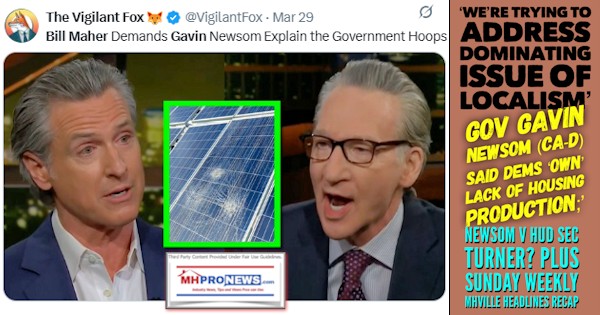
e) Let’s do some math to illustrate what routine and robust federal preemption could mean for MHVille.
Picture manufactured housing increasing by 500 percent over a period of time following a robust and sustained move by HUD to enforce federal “enhanced preemption.” That 5x growth would be less than the increase in ADU’s in CA post-preemption reform, so it is modest by comparison and thus entirely reasonable. 2024 witnessed 103,314 new HUD Code manufactured homes produced, so 103,314 x 5 = 516,570.
That 516,570 potential production of HUD Code manufactured homes would be higher than the production level achieved in 1998 but would still be lower than was achieved in the period just before the HUD Code went into effect in the early 1970s. So, is that 516,570 potential HUD Code manufactured housing production by historic metrics a reasonably achievable potential? Yes.
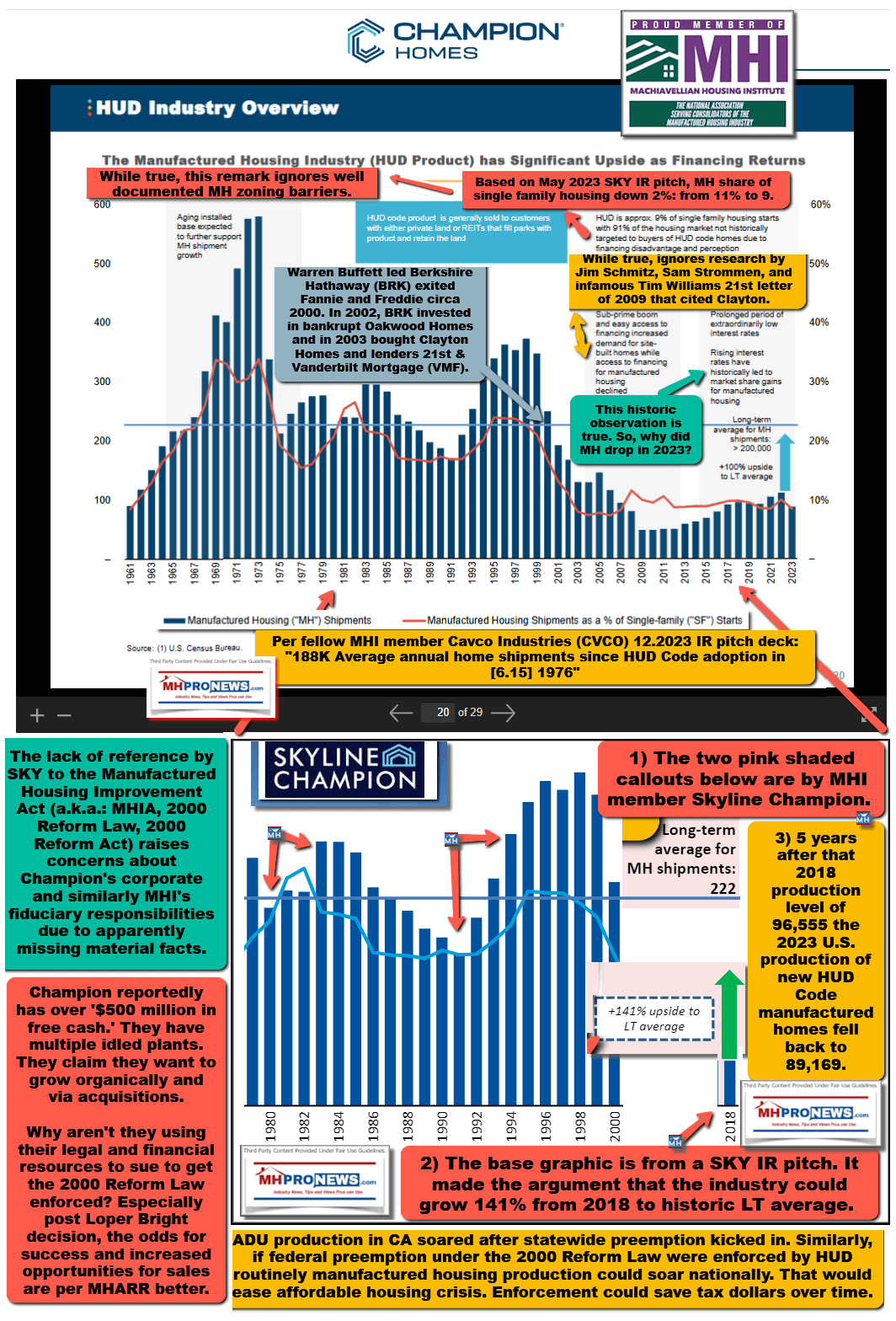
f) Federal Reserve linked researchers have not mentioned enhanced preemption, but they have specifically pointed to how zoning has been used to limit the industry. They focused on removing the permanent chassis, which according to sources deemed reliable, MHARR had negotiated in the 1990s in what was going to be the Hiler Amendment, named for the Congressman John Patrick Hiler (IN-R). But MHI, per sources, pulled out of support for the Hiler Amendment just before it was supposed to be acted upon by legislators on a bill that was moving.
There is no mention of that lawmaker’s name on the public side of the MHI website.

- Why is it that time and again, MHI seems to do the wrong thing?
- Why does MHI consistently snatch defeat from the jaws of victory?
- Why has MHI openly begun siding with conventional housing interests that Federal Reserve researchers have said are part of the problem for HUD Code manufactured housing?
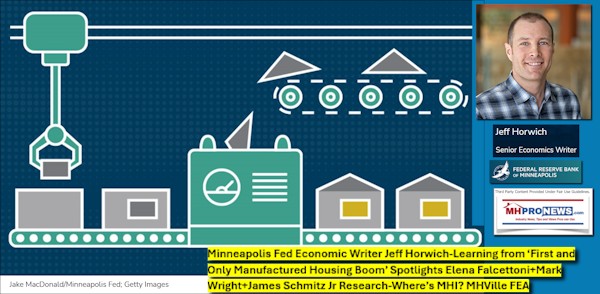
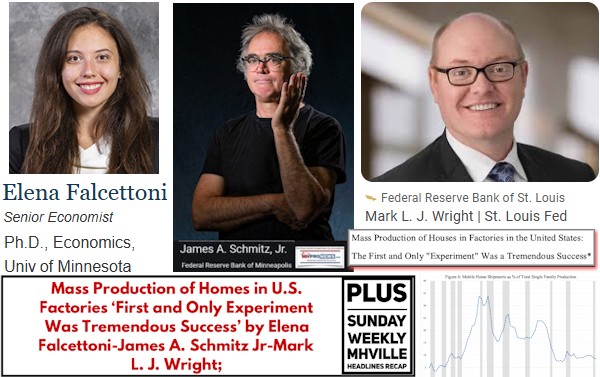
7) With those points in mind, let’s pivot back to some pull quotes from Harry J. Abramson insights presented in Part I.
Abramson’s remarks included the following – which are things to do (e.g: PROMOTE, PROTECT AND IMPROVE including image building and a mission statement that is more than just rhetoric) and things to avoid (Cronyism, Domineering Factions, etc.).
Per Abramson were the following. Bold is in the original in several of these, but is added by MHProNews in the last two quoted bullets.
- “PROMOTE, PROTECT AND IMPROVE THE REP FUNCTION” is something to do.
- “Cronyism” is something to avoid.
- “Domineering Factions” is something to avoid.
- “Image Building” is something to do.
- The perfect trade association has a mission statement that is more than just rhetoric.
- Trade associations are like people and companies – neither is perfect. However, they exist for solid reasons. They provide benefits and a collective voice. If they don’t, you may be in the wrong one.
7a) Clearly, the industry’s image campaign as promised by Kevin Clayton in a 2011 video interview or discussed by MHI in 2005 after the release of the MHI commissioned Roper Report never occurred.
7b) When MHI rolled out what they initially called the “new class of manufactured home” and was later rebranded as CrossMod ®, big claims and promises were made. But in hindsight, it is apparent that it CrossMods have never been what was pitched and claimed. That’s what some in MHVille have called examples of “razzle dazzle” – with that “razzle dazzle” being a federal cautionary tale: flashy claims without demonstrable KPI measurable results.
In considering the remarks by MHI issued to their own actual and potential members, shown below, note that in hindsight it was worse than “just rhetoric” Abramson cautioned against in his thesis presented in Part I.


Indeed, in hindsight, the credibility of the MHI “research” that was part of the foundation for CrossMods must logically be questioned.
Why?
Because Freddie Mac found in their research that 56 percent of the public would consider buying a HUD Code manufactured home.
While Freddie Mac has their own issues, addressed in part in the analysis of their research shown below, nevertheless their research is clearly more credible than MHI’s “rhetoric” which said that only 9 percent of the public would consider buying a manufactured home. Given the wide miss between what MHI, Kevin Clayton, and others claimed and what MHI had to admit in a letter to a regulator (see third-item linked below), it should be clear that the MHI commissioned research was in one or more ways flawed.


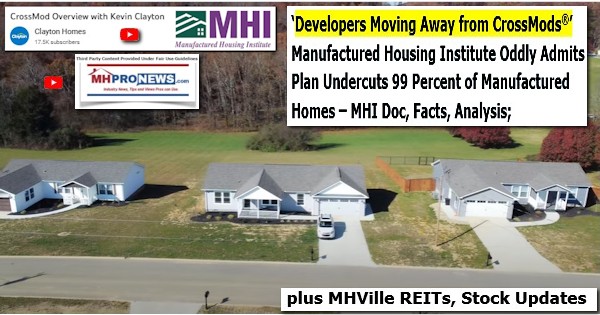
As nice as those CrossMods may look, newcomers to the industry may need to be informed or reminded that something as good or better was produced by HUD Code builders prior to the rollout of CrossMods. All of the homes shown in the top left of the collage below were pre-CrossMod ® HUD Code manufactured homes. They were also lower in cost per square foot than CrossMods. As an MHI member-producer told MHProNews in off the record remarks, his firm ‘put a pencil’ to the product and the available financing. Per that MHI member source, even with the cheaper financing, offering customers CrossMods ‘didn’t pencil out.’ A tape and textured (for example) HUD Code home cost so much less that even with more costly lending, they could still be have lower down payments and monthly payments than CrossMods. Ooops?
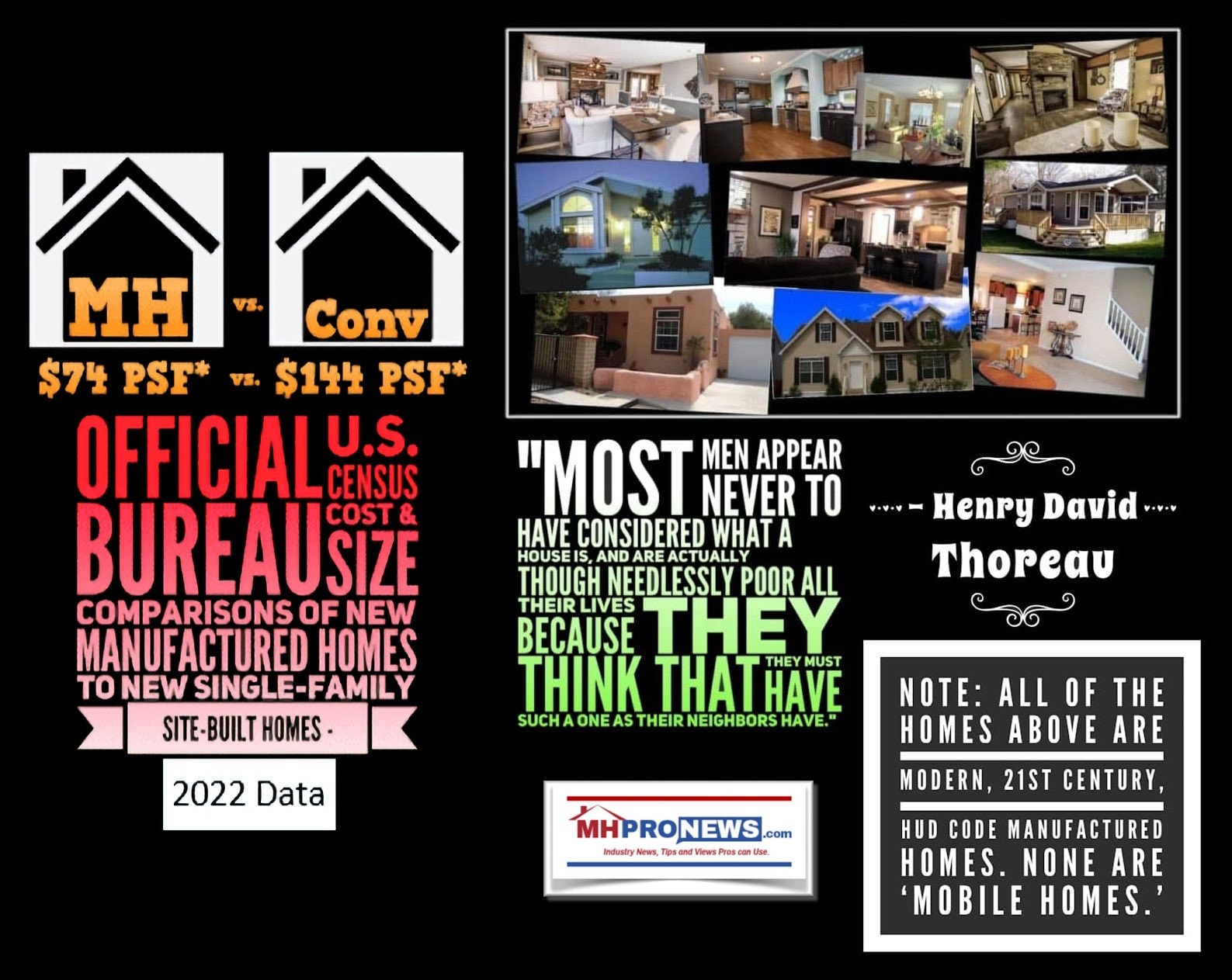
Also, well before CrossMods, there were garage model attachments made for manufactured homes.

So, what exactly was the benefit to the industry – if any – to the much-touted CrossMods campaign?
Results are so low that to this day there is no evidence publicly provided by Clayton Homes or MHI as to the total number of such models built since its inception.
One may wonder if CrossMods was truly meant to help, or harm, MHVille?
Keep in mind that MHProNews early on warned that this program was a “Trojan Horse” that aimed to undermine what MHARR has since referred to as mainstream manufactured homes. Inside and outside of the boundaries of manufactured housing, informed observers complained about the premise and execution of the Clayton backed and MHI branded CrossMod ® scheme.
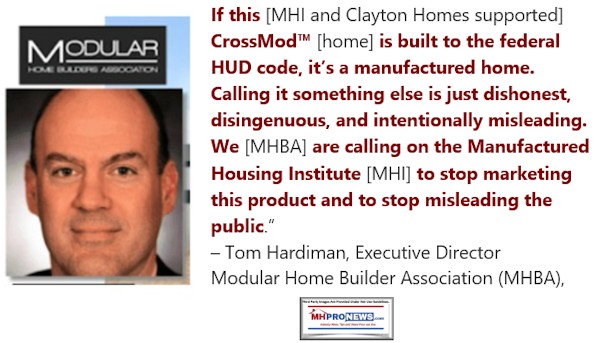

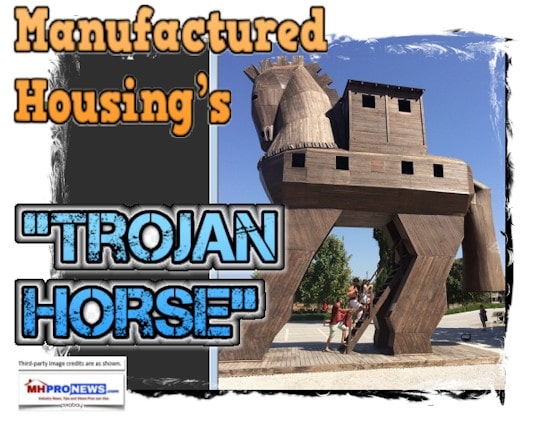
Here is a Q&A with Bing’s AI powered Copilot to confirm the facts about the concerns and evidence shown herein.
Copilot looking for an update on a prior topic. To my knowledge there is no published total by the Manufactured Housing Institute, Clayton Homes, Champion Homes, or Cavco Industries as to exactly how many of the “new class of manufactured homes” later rebranded as CrossMod (R) homes have been built, is that still an accurate statement? Haven’t MHProNews, MHLivingNews, MHARR, and Tom Hardiman for the Modular Home Builders Association all issued reports with evidence and expert commentary that called into question the logic of what MHProNews called a potential “Trojan Horse” for manufactured housing? Isn’t the logic clear that if the product was a success that their would be hard data to support the hype they’ve used since they began to pitch that product? Correct, confirm or clarify and link results as warranted.

MHProNews, MHLivingNews, MHARR, and Tom Hardiman of the Modular Home Builders Association have indeed issued reports and expert commentary questioning the logic behind CrossMod® homes. MHProNews has referred to the initiative as a potential “Trojan Horse” for manufactured housing. MHARR has also criticized the program, arguing that it diverts resources and attention away from traditional HUD Code manufactured homes.
The logic behind the skepticism is clear: if CrossMod® homes were a resounding success, there would be concrete data supporting their adoption and effectiveness. Instead, reports indicate that developers are moving away from CrossMod® homes due to concerns about faulty appraisals and financing challenges.
Let me know if you’d like further details or analysis!
1 www.manufacturedhousing.org 2 www.manufacturedhomepronews.com 3 www.manufacturedhomepronews.com 4 www.manufacturedhomepronews.com
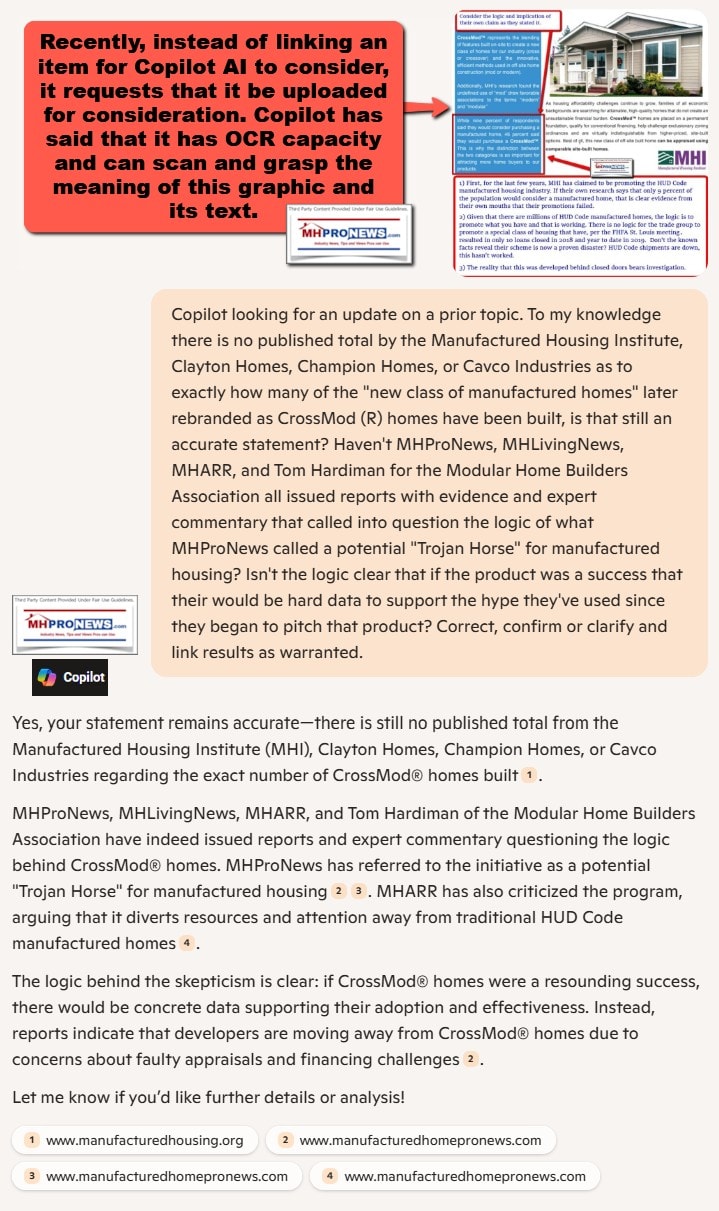
8) Early in the history of the Manufactured Housing Association for Regulatory Reform (MHARR) website, MHARR issued a public report linked below which is arguably a direct challenge to the claims of effectiveness that MHI and many of its 21st century leaders have claimed.
As perhaps another indirect piece of evidence of the concerns expressed by the industry’s members related to MHI, the smaller and production focused MHARR website reportedly has more traffic than is reported by SimilarWeb for MHI. Restated, interest in what MHARR has to say about industry issues eclipsing MHI’s traffic is yet another indicator that MHI is ‘failing’ at its own self-proclaimed mission. Combine that with the evidence that MHProNews’ traffic has been documented to exceed that of MHI and its larger bloggers and trade publishers combined by a factor of over 6x are reasons to believe that ‘trust’ in MHI is waning.
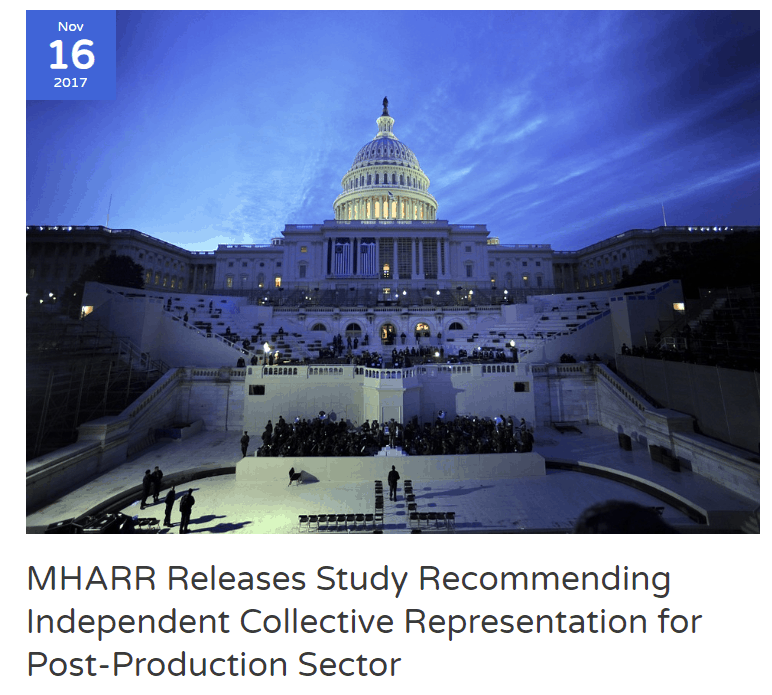
More on the above study by MHARR will be explored further below. Next, let’s press onto to what initially appeared to be a hopeful development in the wake of MHARR’s published study, linked above.
9) Not long after MHARR issued that call to action for a new and effective post-production trade group, the launch of NAMHCO was announced. While it may have been coincidental, the departing MHI state affiliates involved specifically called MHI out for its failures to perform.
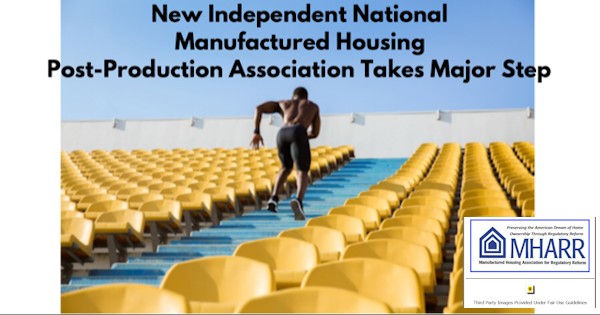

It should be kept in mind that even loyal MHI members that stayed in the trade group criticized MHI for failing to address, for example, the need for competitive chattel lending.
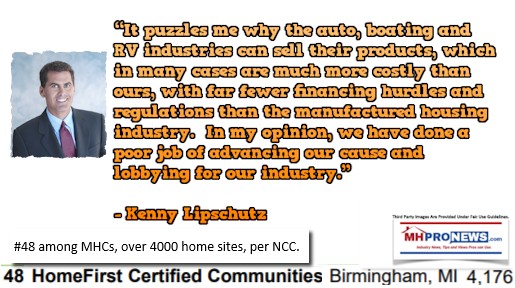
10) NAMHCO was launched as a new trade group and was thus a hopeful step. At least NAMHCO appeared to be so until a former MHI VP – Tom Heinemann – was tapped to take the lead for that newborn organization’s advocacy. Tom Heinemann is one of several ex-MHI VPs, presidents/CEOs, along with a periodically critic of that trade group – yet MHI award-winner – plus others that for whatever reasons were purged in a what has been described as a Orwellian memory-hole fashion from the MHI website.
Did Heinemann act as a saboteur for MHI? That is uncertain and thus unknown.

But what was clear is that some MHI leaders (see below) were publicly opposed to the birth and development of NAMHCO. Which begged the question. Why did NAMHCO, after Heinemann was brought on board, team up with MHI on a bill? Meaning, whose side was former MHI VP Heinemann on? What was the logic of teaming up with MHI after leaving them?
11) Given that MHI is demonstrably failing the independents of the manufactured home industry, while apparently working for the consolidation-focused companies, the wisdom of those who roughly a decade or more ago said wanted a new post-production trade group begins to shine. As Bob Crawford put it, ‘if we keep doing what we’ve been doing we will keep getting what we’ve got.’ Or as Abramson said:
If they don’t [deliver on the qualities needed for a good trade group], you may be in the wrong one.
Meaning, Abramson was making the argument that if your trade groups doesn’t deliver on the DO and DON’T Do items he listed above, it is time to look for (or create) a new trade group.
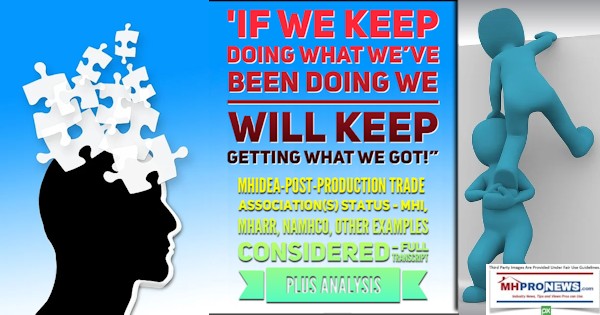
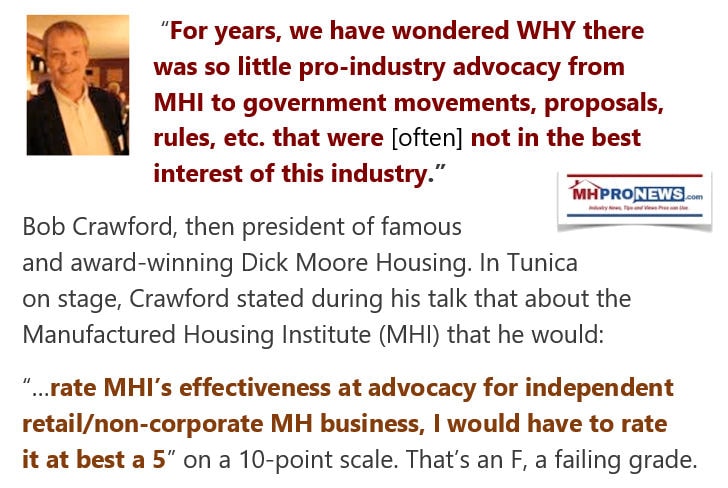
12) With that in mind, the PDF of the Word document version of the MHARR study linked found on their website above in #8 is also found at this link here. That study included the following remarks. PPS meant “post production sector” which was by inference a reference to MHI.
the failure of the PPS to join with MHARR in publicly calling for – and demanding – the removal and replacement of the current career HUD manufactured housing program administrator who is responsible for each of the foregoing regulatory abuses.
a) This is arguably one of several reasons why looking back at history can prove useful. That MHARR reference was to problems being fostered at that time by the Office of Manufactured Housing Program (OMHP) administrator Pamela Beck Danner, J.D. Why indeed did MHI fail to join MHARR in insisting on the removal for cause of Danner?


b) Oddly, instead of joining with MHARR to remove her, MHI featured Danner at one of their events, as if she was a celebrity.
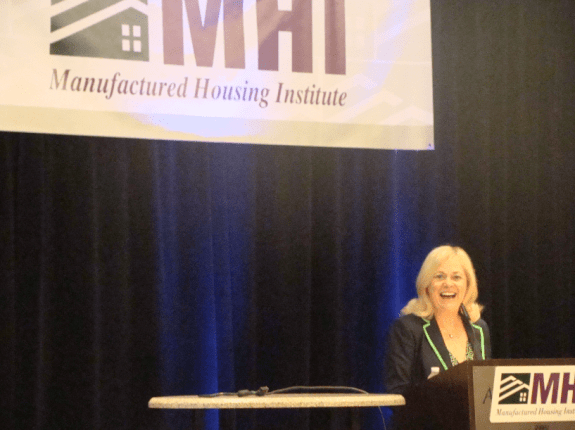
That invitation of Danner to address MHI one of their events was despite the fact that as MHARR outlined in their post-production study that Danner was not only failing to routinely enforce “enhanced preemption” MHARR said in plant inspections and other problematic issues were being stirred up during the Danner regime at HUD’s Office of Manufactured Housing Programs (OMHP).
Here is how MHARR framed it in their document referenced above and linked again here.
c) Quoting from MHARR’s post-production study.
These include, but are not limited to: (1) HUD’s failure/refusal to federally preempt local “zoning” or placement restrictions that discriminatorily exclude HUD-regulated manufactured homes and the lower and moderate-income Americans who rely on the industry’s homes as a source of affordable, non-subsidized housing and/or home ownership; (2) HUD’s ongoing effort to dictate state-law installation standards and programs to already-approved “compliant” states on a one-size-fits-all basis from Washington, D.C.; (3) HUD’s effort to substantively alter, via “interpretation,” its standards for “frost-free” foundations and its parallel effort to force that interpretation on states with state-law installation standards and programs; (4) HUD’s needlessly complex, costly and restrictive regulations for “on-site” construction; (5) HUD’s failure to object to baseless and extraordinarily costly “energy” standards developed by the U.S. Department of Energy (DOE) for manufactured homes; and (6) HUD’s baseless restrictions on attached garages and carports, just to name a few.
Don’t forget that MHARR’s choice of words were so sharp that the left-leaning Washington Post cited them in their report about the ruckus at HUD’s OMHP. Note how WaPo framed it: a “once obscure” office. That’s apparently how little the biggest publication in Washington, D.C. for decades placed on the manufactured housing program.
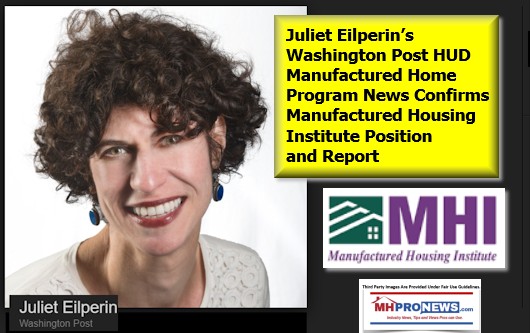
d) It should be kept in mind that MHI claims to have a 50-year “partnership” with HUD. If they have had a partnership, why did MHI put up with the very real concerns raised by MHARR shown above? Hold that thought too.

e) Keep in mind that Danner’s time at HUD was during the Obama-Biden (D) Administration. Joe Biden was a cosponsor of the Manufactured Housing Improvement Act of 2000, so he should have known about its “enhanced preemption” provision. Yet, despite that useful letter from Democratic lawmakers about federal preemption powers to Bush-43-era HUD Secretary Mel Martinez, cited above, why didn’t Democrats unite under Obama-Biden to press for full and robust enforcement of that provision of the 2000 Reform Law when they held all the levers of power?
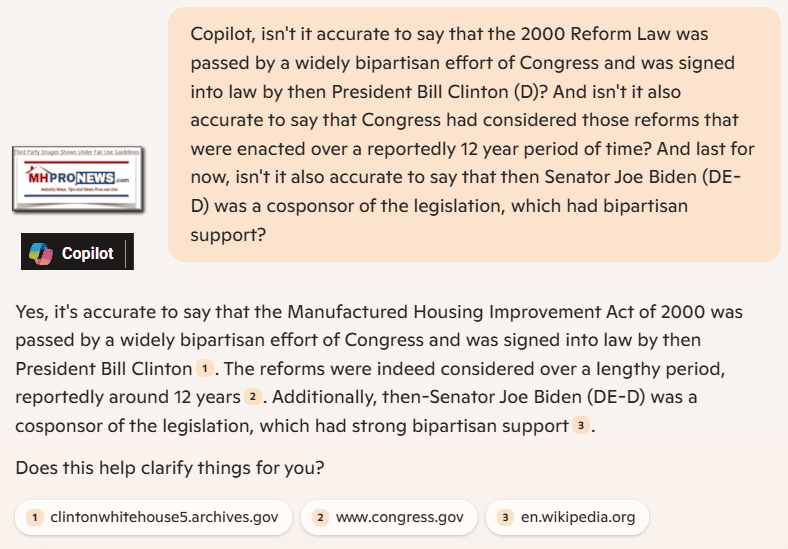
f) So, while Democrats complained (see Part II 6b) when Republican (Bush 43) appointed HUD Sec. Mel Martinez was failing to “enhanced preemption,” once Democrats were in power, they effectively did nothing different.
g) Indeed, there is an evidence-based case to be made that matters got worse for manufactured housing during the Obama-Biden years.
The letter from Democrats was issued in 2003. When Obama-Biden entered office in 2009, that production went lower still. Look again at what happened to production during that timeframe. The industry hit its two lowest years (2009-2010) in decades while Democrats were in office. That despite the fact that the Housing and Economic Recovery Act (HERA) of 2008 with its Duty to Serve (DTS) provision was made law in the waning months of the Bush-Cheney era.

h) To discern what might have been occurring, consider this famous quote about regulators.

The John Kenneth Galbraith quote reminds readers that industries often have quite a bit of influence over their ‘regulator.’ MHI claims as much with their own 50-year celebration logo.

i) But perhaps like a liar who can’t keep their conflicting lies straight, MHI acted feckless in the face of what MHARR was consistently and persistently opposing. Not only was MHI leadership seemingly feckless, but they also brought in Danner to address their trade group. To what end? More razzle dazzle? To show their access? Or was it to show others in the industry that they ruled the roost?
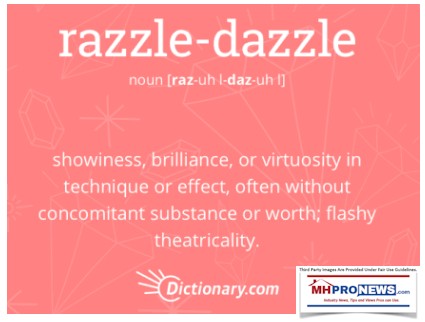

Games of Razzle Dazzle | Office of Justice Programs
This article for police describes the characteristics and variations of ‘Razzle Dazzle,’ a no-win gambling game set up by unscrupulous operators at roadside stops.
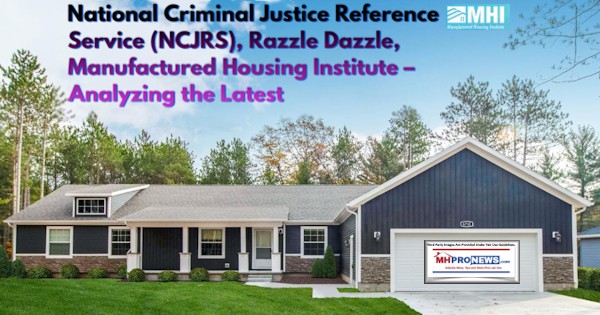
j) But whatever the MHI leadership motivation might have been, given their apparent access, why didn’t MHI get from Pam Danner and HUD what manufactured home industry independents wanted? Keep in mind that MHI claims to represent “all segments” of the industry, not just the consolidators of the industry. Why didn’t MHI use their access and influence to deliver on routine and robust enhanced preemption enforcement by HUD? Hold those thoughts.
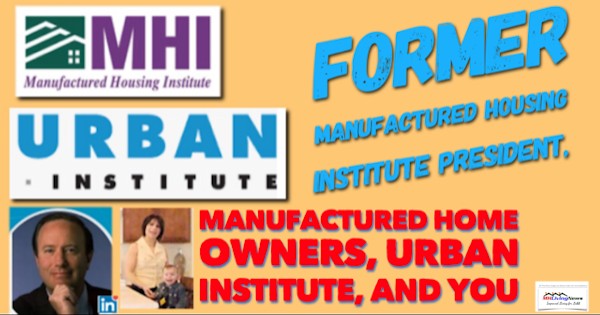
13) But here are some often-overlooked factual points. Barack Obama (44th president) and Joe Biden (VP) took the oath of office on January 22, 2009. Barack Obama had the public support of Warren Buffett. Buffett-led Berkshire Hathaway (BRK) is the parent company of not only Clayton Homes but also 21st Mortgage Corporation, the side of the lending that “serves” manufactured home independents, while Vanderbilt Mortgage and Finance (VMF) serves Clayton owned retail sales centers. Now look at the date of the letter from Tim Williams below. On January 30, 2009 – just 8 days after Obama-Biden are sworn into office, Tim Williams issued the following document (annotation is by MHProNews). To see a larger or full-size version of that Tim Williams/21st Mortgage letter, in most devices you can click here and follow the prompts. Samuel Strommen with Knudson Law called this letter an apparent tying antitrust violation.
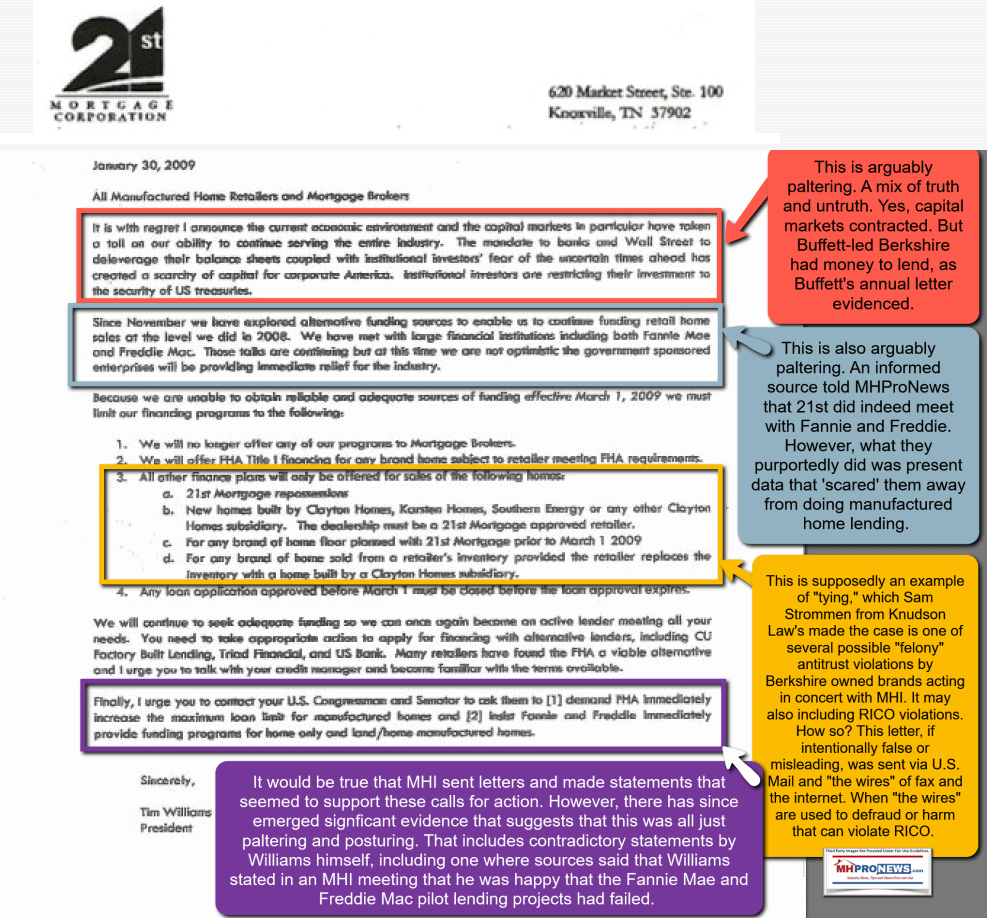
14) That letter sent shock waves and ripple effects through manufactured housing. It was after that Williams/21st letter above, months after Congressionally enacted and Bush-43 signed HERA 2008 and its Duty to Serve manufactured housing provision, that apparently ultimately led to the bankruptcy and/or financial plight of several manufactured housing firms that had despite the loss of Fannie Mae and Freddie Mac lending circa 2000 had managed to survive until that time. The Williams letter was an apparent kill shot. The Williams/21st letter is arguably THE Smoking Gun document for launching an antitrust or other probe into the dark forces undermining manufactured housing in the 21st century. Keep in mind that per the DOJ when an ongoing conspiracy is at work, it is not until the final act in a conspiracy that the statues of limitations begin to run.
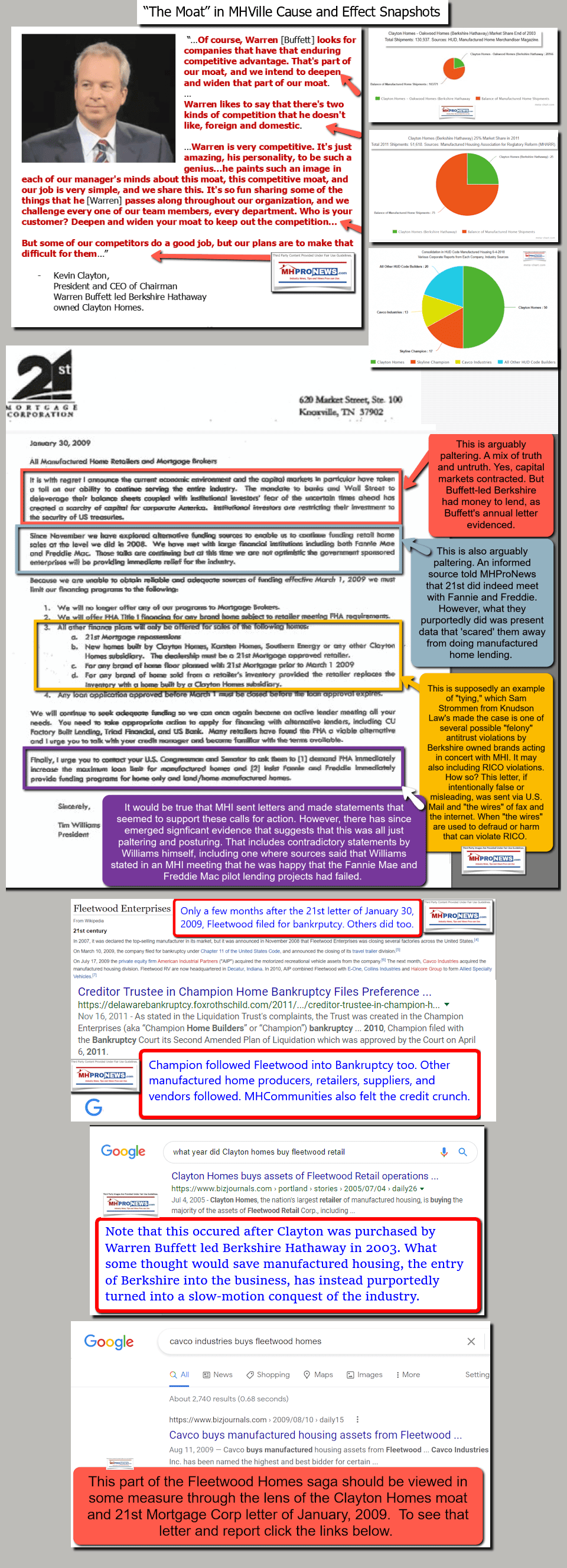
15) By deliberately undermining lending, given that Eric Belsky called credit “the life blood” of housing, Clayton/21st/Berkshire Hathaway essentially undermined many of the manufactured housing industry’s independent retailers.
It was only a question of time that producers that supplied those retailers also suffered.
Furthermore, for decades the business model of many if not most of the thousands of independent land lease manufactured home communities was that so-called manufactured home “street retailers” filled their vacancies. But when the street retailers dwindled by the thousands following the late 1990s-early 2000s meltdown, many of those land-lease communities began to suffer from increased vacancies as a result.
Keep those factoids in mind in considering the quote in #16 below.
So, the “weak link” or “imperfection in the market” of financing, coupled with the “weak link” of zoning barriers, stymied manufactured housing as potent barriers.

16) Nor is the above merely journalistic punditry or speculation. Every aspect is grounded in solid evidence, often from those involved and/or their longtime allies. For example. Longtime Buffett ally William “Bill” Gates III is quoted by left-leaning CNBC on 11.8.2019 saying the following. Bold is added by MHProNews for emphasis.
“I didn’t even want to meet Warren [Buffett] because I thought, ‘Hey this guy buys and sells things, and so he found imperfections in terms of markets, that’s not value added to society, that’s a zero-sum game that is almost parasitic.’ That was my view before I met him … he wasn’t going to tell me about inventing something,” [Bill] Gates said at the [The New York Times/DealBook] conference.
That statement by Gates about Buffett is revealing.
- A parasite feeds on its host.
- Here is how the Centers for Disease Control (CDC) defines parasite: “A parasite is an organism that lives on or in a host organism and gets its food from or at the expense of its host.”
- That term parasitic was the root word Bill Gates used to describe how admitted he saw Warren Buffett’s business model.
Nevertheless, despite that “almost parasitic” business model that seeks “imperfections in terms of markets,” the two obviously got together on numerous business, nonprofit, and political levels.
Clearly, whatever held Gates back about Buffett before they finally got together, Gates obviously overcame.
What Gates didn’t claim in that quote is that Buffett changed his business methods. There is an inference to be drawn from those statements that Gates learned from Buffett and embraced that parasitic business model that sought imperfections in markets.
Several facts need to be kept in mind that relate to Gates and Buffett, each of whom served for years on the boards involving the other.
17) For instance. One should recall that Gates’ Microsoft was found to be a monopoly in a legal action.
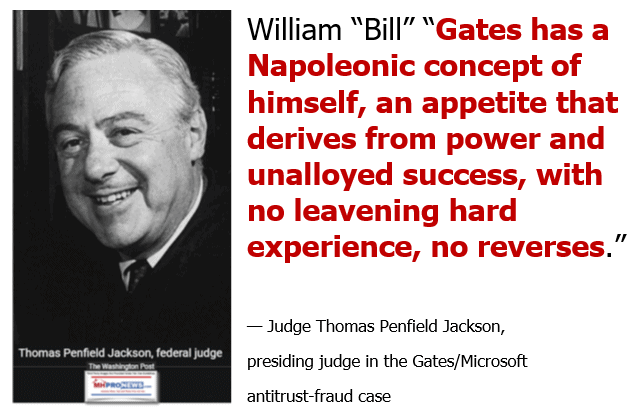
Per left-leaning Google’s AI powered Gemini.
The Microsoft antitrust case was a landmark American antitrust law case2. The U.S. Justice Department sued Microsoft, accusing it of illegally using its Windows operating system near monopoly to overwhelm rivals and hurt consumers13. In 2000, U.S. District Judge Thomas Penfield Jackson ruled that Microsoft had violated antitrust laws by engaging in monopolistic behavior and called for the company to be split into two separate entities5.
Nor should it be thought that Buffett led-Berkshire (BRK) hasn’t faced similar criticism and legal actions.

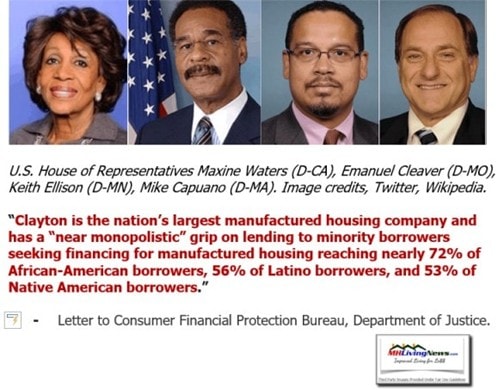
18) As the report linked below cited among other details, pro-Buffett, pro-Charlie Munger, pro-Berkshire author Bud Labitan specifically described Clayton Homes lending as part of their “moat.” Think of that “moat” as operating principles that made parasitic behavior seemingly profitable and less likely to draw antitrust attention. Note too that what Buffett said in that Q&A captured on Yahoo News video, it was specifically a discussion about manufactured home lending.

Minneapolis Federal Reserve linked research economist Donna Feir said this. Note the similarities between Feir’s remarks and those of Rep. Maxine Waters and her colleagues, cited above. Each pointed to the Seattle Times series that exposed problems with Clayton’s lending practices.

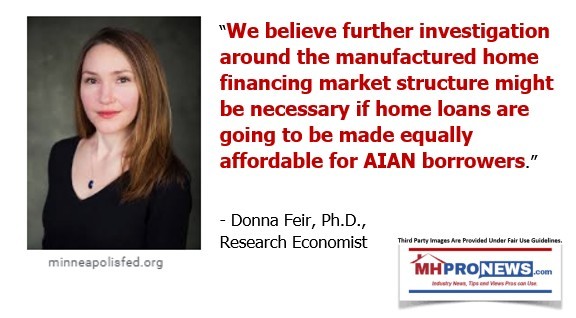
19) As MHProNews has disclosed several times, the ‘illusory truth’ methods of MHI frankly worked on us for a time too. But a series of tips and revelations began to make it clear that MHI was on several instances saying one thing but doing something else quite at odds with their own claims. MHI leaders were at times paltering. They were at times posturing. One such example is this key statement made by Kevin Clayton on behalf of MHI in his testimony to Congress. Grant that the first three quoted statements below by Clayton were essential true. So too was the highlighted portion of the next statement where Clayton said that lack of liquidity “accounted for more than” 160 plant closures, more than 7,500 [street retail] home centers, and the loss of 200,000 jobs.
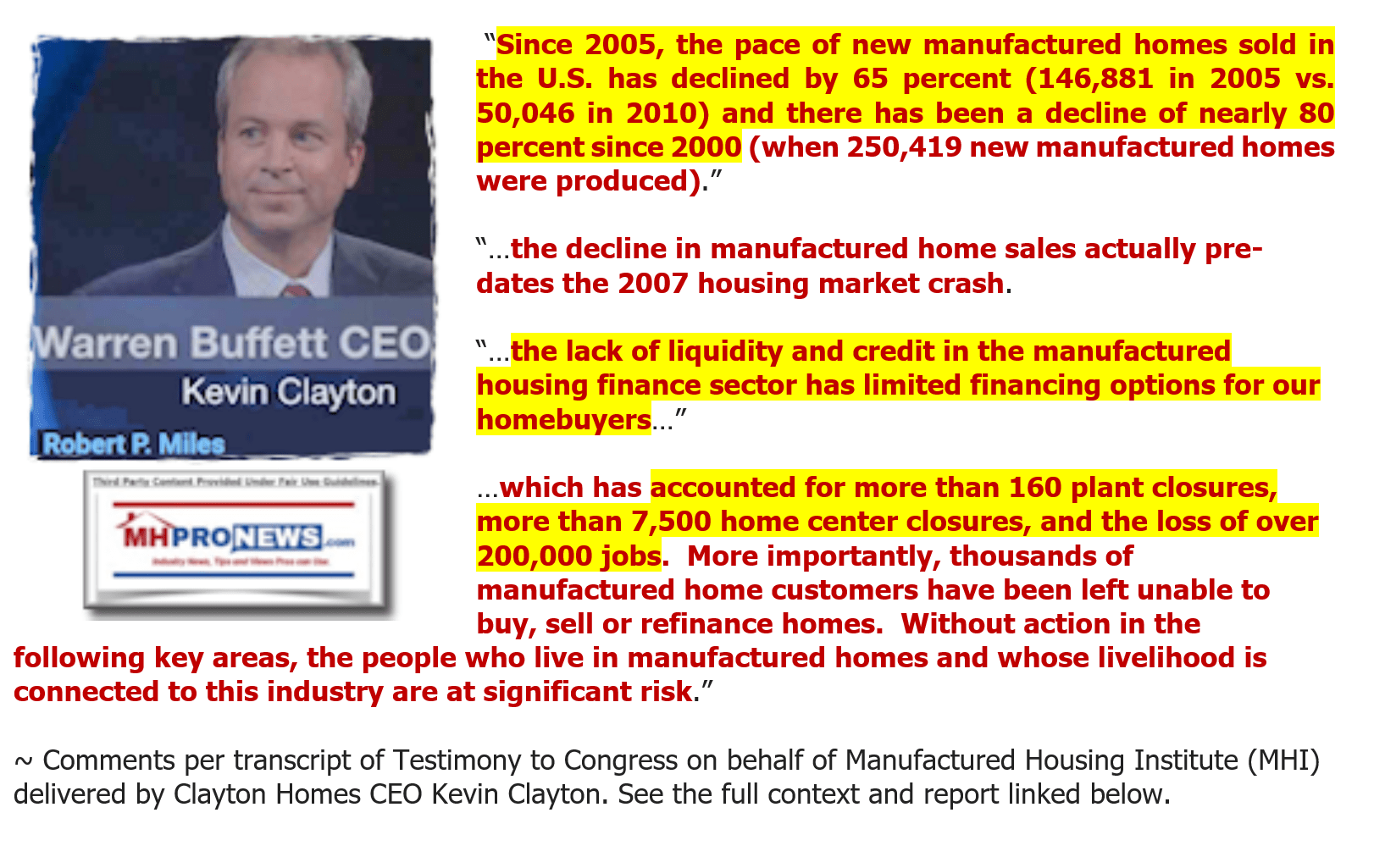
In the instance above, it is not so much what Clayton said in those specific remarks as it was what he didn’t say.
Clayton didn’t say that Warren Buffett led Berkshire Hathaway’s sold off interests in Fannie Mae and Freddie Mac.
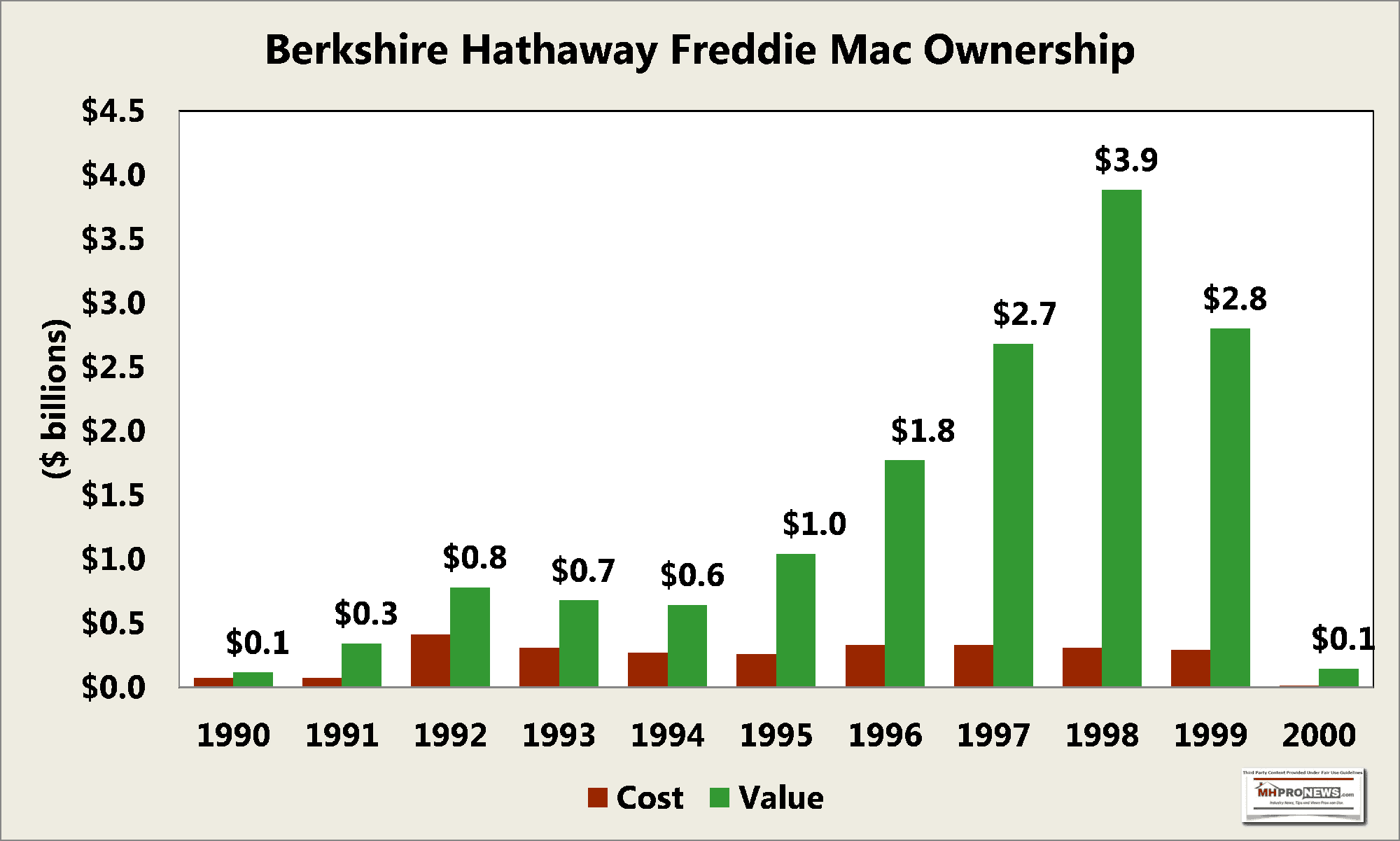
a) A Congressional committee quizzed Buffett about that move, documented above. Those are details that merit a separate report.
b) Perhaps as or more important, because it is hard evidence rather than a hmmm, nor did Clayton mention that infamous 21st Mortgage letter signed by his colleague, Tim Williams, shown above and linked here.
The industry was trending down, despite what former MHI CEO Chris Stinebert said in 2004. What was it that made Stinebert wrong? Did Stinebert pay enough attention to what it may mean that Berkshire would have a direct hand in manufactured housing when Berkshire acquired Clayton, Oakwood, their lending, and later other brands and loan portfolios? How, in fairness, to Stinebert, could he know the keen insights of Bill Gates or the quotable quotes about Buffett and Clayton that emerged from the Nation, GuruFocus, or Robin Harding that would not come until some years later?
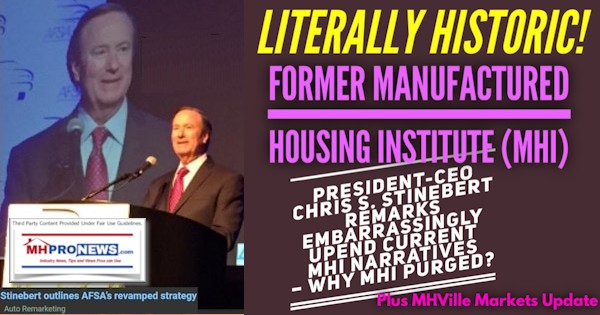
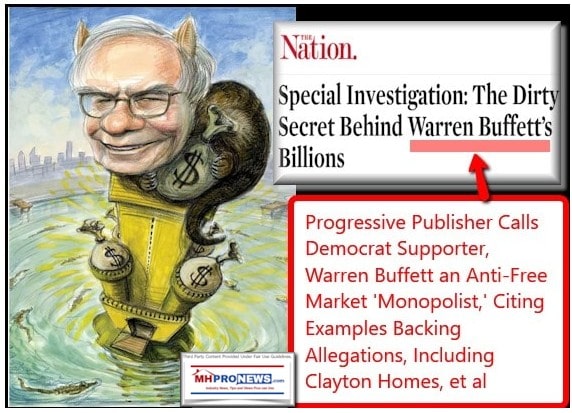
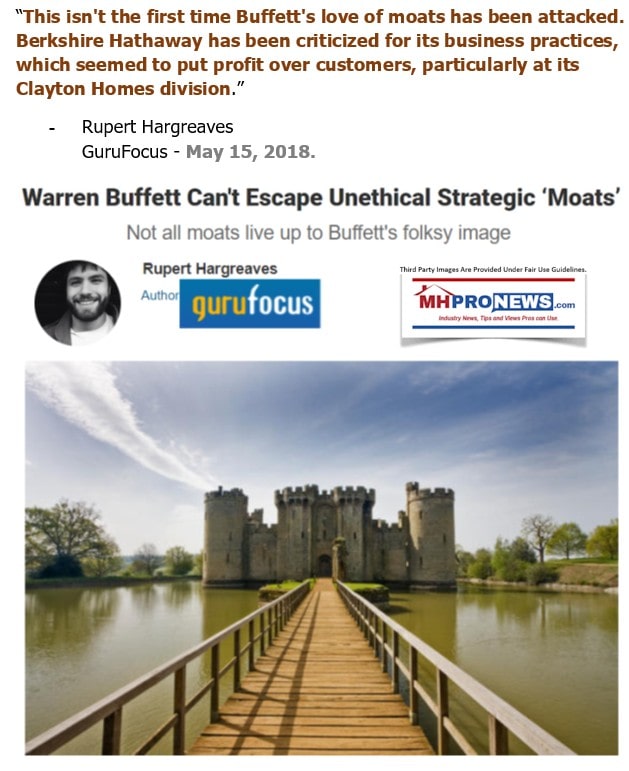
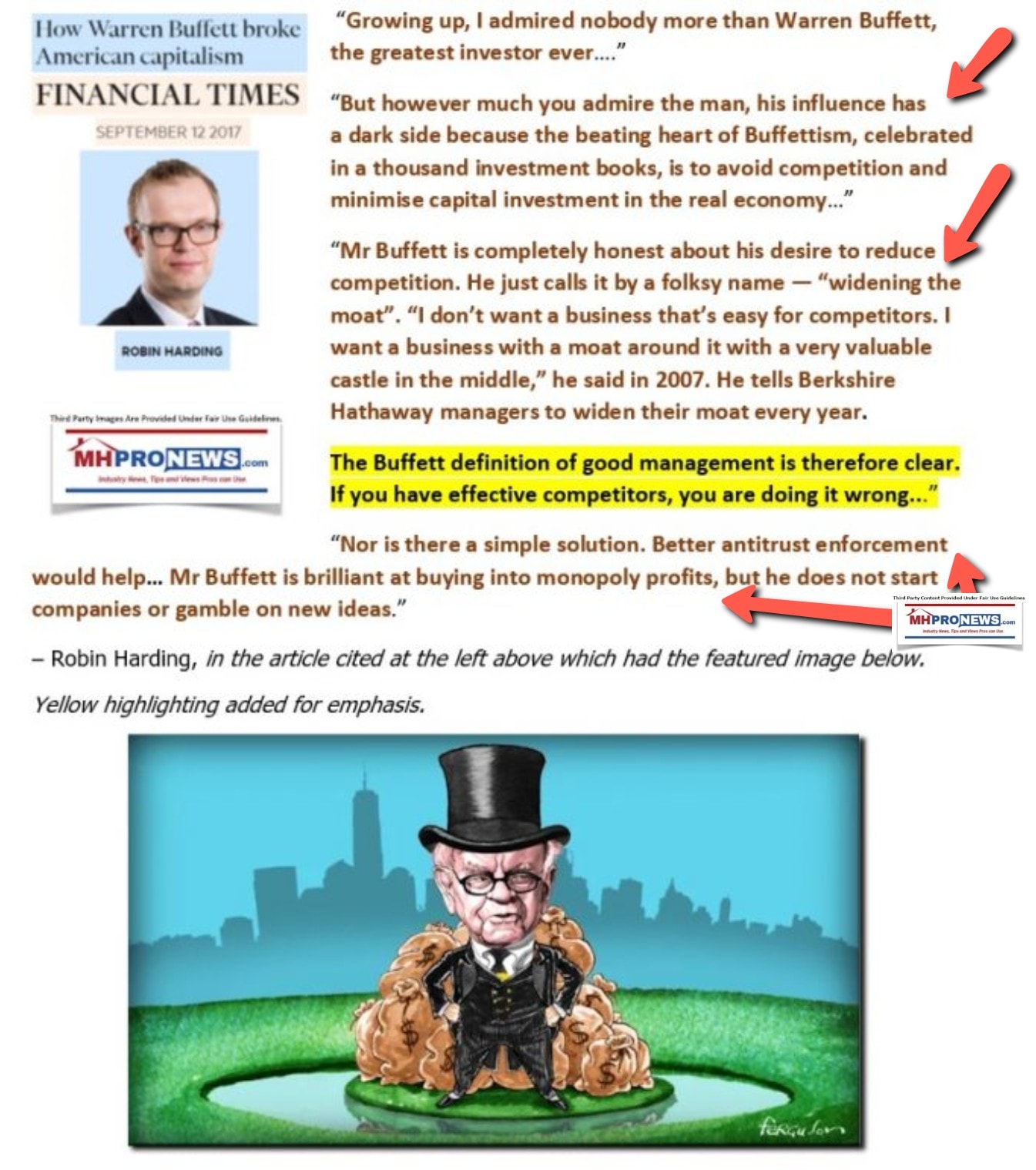
Notice how closely Harding’s observations mirror those of Bill Gates, quoted above? Put the two side by side (one after another, below) to emphasize the point. Bold is added by MHProNews.
- “Mr. Buffett is completely honest about his desire to reduce competition. He just calls it by a folksy name – widening the moat”. “The Buffett definition of good management is therefore clear. If you have effective competitors, you are doing it wrong.” “Mr Buffett is brilliant at buying into monopoly profits, but he does not start companies or gamble on new ideas.” – Robin Harding (see quote graphic citing the Financial Times above).
- “I didn’t even want to meet Warren [Buffett] because I thought, ‘Hey this guy buys and sells things, and so he found imperfections in terms of markets, that’s not value added to society, that’s a zero-sum game that is almost parasitic.’ – Bill Gates as quoted by CNBC.
To further clarify the importance of the above, consider what Kevin Clayton said to pro-Berkshire interviewer Robert Miles. Notice Clayton said what Harding said, Buffett doesn’t want competition. Buffett wants his unit managers to eliminate competition. “Our plan is to make that difficult for them,” with them being “competitors that do a good job.”
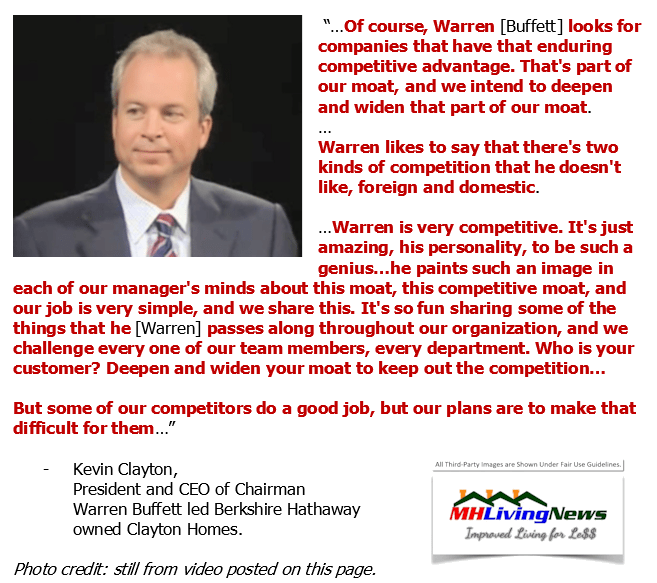
20) Antitrust researcher Samuel Strommen for Knudson Law cited several articles published by this author, but among them that he pointed to and specifically praised was this next one.
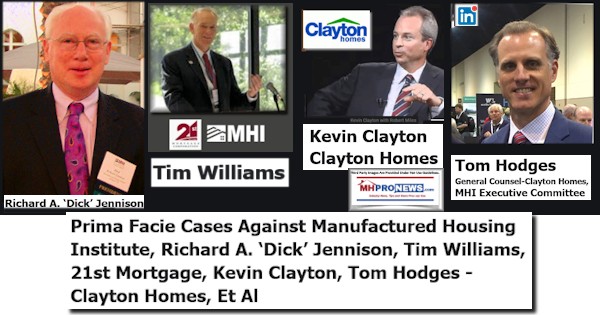
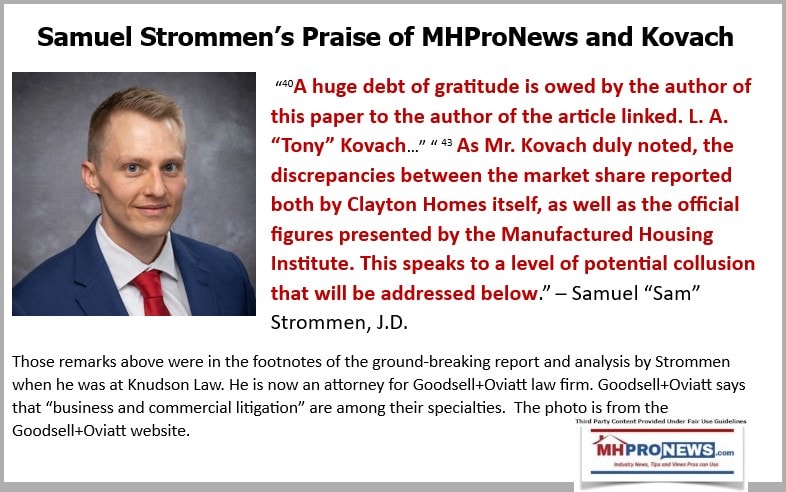
Strommen noted that no antitrust action has been taken by federal officials against Buffett led Berkshire’s Clayton Homes and their related lending (21st and VMF). But he said that a lack of action doesn’t mean that it action isn’t merited.
21) Some additional facts need to be considered.
- Waters and her colleagues provided the DOJ and CFPB with a referral against Clayton, per those lawmakers’ letter. That was during the Obama-Biden years. Buffett and Obama were tight, as was noted above. Isn’t that the kind of cronyism (on the MHI level) that Abramson cautioned against for a good trade group?
- During the first term of President Donald J. Trump (T1), sources asserting knowledge told MHProNews that a Clayton homes specific meeting was held with DOJ antitrust attorneys. There was also an indication from a former DOJ antitrust official during T1 that “elections have consequences,” seeming to imply that the Trump-era DOJ may have moved ahead with antitrust action against Clayton, their lending, etc. had Biden not taken office after the heavily disputed 2020 contest.
22) With the above in mind, MHProNews asked AI powered Google Gemini to do “deep research” into the manufactured housing industry. This article was backdated one year, so that it didn’t appear on the home page, but allowed Gemini to scan the contents, follow the links, check it against other sources, and see if the article is accurate on sourcing and logical in its findings. Gemini was told in the inquiry that their findings would be added to the article, which would be finalized and published today.
With that in mind, here is what Gemini deep research yielded.
Analysis of Factors Influencing Manufactured Housing Industry Performance in the 21st Century
Executive Summary: This report analyzes the factors contributing to the underperformance of the manufactured housing industry in the 21st century, as highlighted in an article from MHProNews. The analysis confirms the accuracy of several key concerns raised in the article, supported by a review of provided research materials. Specifically, the consolidation trend within the industry, the antitrust actions against prominent companies like Sun Communities and Equity LifeStyle Properties, and the historical challenges in securing chattel financing despite the Duty to Serve mandate are substantiated by the evidence. The report also examines the role of the Manufactured Housing Institute (MHI), contrasting its approach with that of the Manufactured Housing Association for Regulatory Reform (MHARR). The findings suggest a potential disconnect between MHI’s broad representation of industry interests and the specific needs for growth and consumer access in the affordable housing market. The historical decline in manufactured housing production levels underscores the persistent challenges. Finally, the report considers the potential benefits and drawbacks of establishing a new post-production trade group to work alongside MHARR in advocating for the industry’s advancement.
Detailed Analysis of the Provided MHProNews Article:
The article from MHProNews raises several critical points regarding the manufactured housing industry’s performance in the 21st century. A detailed examination of these points, cross-referenced with the provided research material, reveals significant corroborating evidence.
Verification of Facts and Quotes: The article cites Flagship Communities’ investor relations materials, indicating the company’s intention to consolidate the fragmented manufactured housing community industry. A review of multiple investor relations news releases from Flagship Communities and their REIT overview consistently demonstrates a strategy focused on acquisitions and expanding their portfolio. Notably, the REIT overview explicitly states, “The REIT is positioned as a consolidator in the fragmented MHC industry”. This strategic direction, as articulated in their own investor communications, directly supports the article’s claim.
Furthermore, the article mentions antitrust actions against Sun Communities (SUI) and Equity LifeStyle Properties (ELS), including their subsidiary Datacomp. A substantial body of evidence confirms these legal challenges. Numerous press releases from law firms , news reports , and legal documents detail class action lawsuits alleging price-fixing of manufactured home lot rents involving these companies and others who utilize Datacomp’s market reports. These legal actions, brought on behalf of renters, assert violations of antitrust laws and common law due to alleged conspiracies to inflate rental prices. The ownership of Datacomp, along with MHVillage and MHInsider, by Equity LifeStyle Properties is also confirmed , highlighting a potential conflict of interest given the antitrust allegations against Datacomp and ELS.
The article also references Federal Reserve research suggesting that conventional housing interests and HUD have historically undermined manufactured housing. Research from the Minneapolis Federal Reserve directly supports this assertion. An economic writer from the Minneapolis Fed quoted Senior Research Economist James Schmitz Jr., who stated that pressure from “stick-built” housing and federal regulation subsequently relegated manufactured housing to a small market share. This perspective from a Federal Reserve economist lends significant weight to the article’s claim.
MHI’s alliance with the National Association of Home Builders (NAHB) is another point raised in the article. Evidence confirms this collaboration, with MHI participating in a “housing coalition letter” to members of Congress alongside NAHB and other groups primarily representing the interests of the conventional housing industry. This alliance, while potentially aimed at addressing broader housing issues, raises questions about MHI’s prioritization of manufactured housing’s unique needs, especially considering NAHB’s focus on site-built homes, which compete in the affordable housing market.
The article highlights the lack of effective enforcement of the Duty to Serve (DTS) mandate for manufactured housing by the Federal Housing Finance Agency (FHFA). A review of FHFA documents and related news indicates the existence of the DTS mandate, requiring Fannie Mae and Freddie Mac to facilitate a secondary market for mortgages on housing for very low-, low-, and moderate-income families in underserved markets, including manufactured housing. However, there is a persistent lack of significant progress in chattel financing, which constitutes a large portion of the manufactured housing market. Fannie Mae itself acknowledges the absence of a well-defined secondary market for chattel loans as a challenge. This ongoing issue aligns with the article’s concern about the failure to fully implement DTS for manufactured housing.
The article mentions controversies surrounding Cavco/Joe Stegmayer and Frank Rolfe. While the provided snippets do not directly address these, the user’s query indicates that the original article contains links that likely provide the basis for these claims, necessitating a review of those links for a complete verification.
Finally, the article contrasts the performance of some MHI members with that of Legacy Housing and UMH Properties, suggesting that organic growth can be profitable. Snippet provides data indicating Legacy Housing’s return on equity and UMH Properties’ funds from operations growth, supporting the idea that companies focused on organic development can achieve positive financial results within the industry.
Evaluation of Logical Consistency: The central argument in the MHProNews article appears to be that the underperformance of the manufactured housing industry in the 21st century is not simply due to external economic factors but is significantly influenced by the actions and priorities of the Manufactured Housing Institute. The article suggests that MHI’s focus on representing the interests of large, consolidation-oriented companies within the industry may inadvertently hinder broader industry growth and the accessibility of affordable housing. This argument is logically consistent with the evidence presented in the research material. The stated consolidation strategies of companies like Flagship Communities, coupled with the persistent lack of progress in areas like DTS enforcement and the challenges posed by restrictive zoning (issues where MHI’s advocacy might be expected), lend credence to the article’s perspective. If MHI’s primary focus is on the needs of a segment of the industry that benefits from limited supply and consolidation, then it follows that efforts to broadly expand the market and increase competition might not be their top priority.
Assessment of External Link Support: The user provided two specific links for evaluation. The Flagship Communities investor relations link, as analyzed above through the provided snippets which likely originated from that source, supports the claim that Flagship actively pursues a strategy of consolidating the manufactured housing community industry. The Minneapolis Fed research link, also analyzed through a corresponding snippet, corroborates the assertion that conventional housing interests and HUD have historically played a role in limiting the growth and market share of manufactured housing. This alignment between the article’s claims and the content of the linked sources strengthens the overall argument presented in the MHProNews piece.
The Manufactured Housing Institute (MHI): An Examination of Effectiveness:
Historical Context and Stated Goals: The Manufactured Housing Institute is the national trade organization representing all segments of the factory-built housing industry. Their membership includes manufacturers, retailers, community owners, suppliers, and financial service providers. MHI states its mission as serving its membership by providing industry research, promotion, education, and government relations programs, as well as building consensus within the industry. Their publicly available information highlights efforts to promote the benefits of manufactured housing, advocate for favorable legislation and regulations, and provide resources to industry professionals. MHI also emphasizes the role of manufactured housing as an affordable homeownership option.
Analysis of Criticisms and Allegations: Despite its stated goals, MHI faces significant criticisms regarding its effectiveness in promoting the overall growth and well-being of the manufactured housing industry, particularly in the 21st century. A central concern, as raised in the user’s query and the MHProNews article, is the perception that MHI disproportionately represents the interests of large, consolidation-focused companies. This alleged bias is seen as potentially detrimental to smaller, independent businesses and to the broader goal of increasing affordable housing access for consumers. The term “illusory truth effect” is used to describe MHI’s repeated claims of being a great trade group despite indicators of underperformance, suggesting that consistent repetition of a message might create a perception of truth that is not fully supported by evidence.
Review of MHI’s Actions and Responses: While MHI actively engages in various initiatives, including advocating for legislation and participating in housing coalitions , there is limited publicly available information indicating direct responses to the specific criticisms of prioritizing consolidators and hindering organic growth. MHARR, in its publications, has pointed out MHI’s lack of decisive action on key industry bottlenecks such as zoning restrictions and the lack of chattel financing. MHI’s news releases and website often highlight positive developments and collaborations , but they do not prominently address the core concerns about their strategic direction and effectiveness in overcoming the industry’s long-standing challenges.
MHI’s Alliances and Strategic Choices: MHI’s alliance with NAHB, as evidenced by their joint participation in housing coalition letters , is a notable strategic choice. While collaboration across the housing industry can be beneficial, NAHB’s primary focus on site-built housing raises questions about potential conflicts of interest. Manufactured housing competes with site-built homes in the affordable housing sector, and policies that strongly favor one might not benefit the other. MHARR has explicitly questioned MHI’s alignment with NAHB on certain issues, suggesting that it might not always serve the best interests of the HUD Code manufactured housing industry. This alliance could potentially explain a less aggressive stance by MHI on policies that would significantly boost manufactured housing production and market share, as such policies might be opposed by the site-built industry.
The Manufactured Housing Association for Regulatory Reform (MHARR): A Contrasting Perspective:
Objectives and Core Principles: The Manufactured Housing Association for Regulatory Reform was formed to represent the views and interests of producers of manufactured housing, particularly smaller and medium-sized independent manufacturers. MHARR’s primary mission is to protect, defend, and advance the interests of its members and the manufactured housing lifestyle for American consumers of affordable housing. Their approach strongly emphasizes regulatory reform, advocating for fair, reasonable, and cost-effective federal regulation of the industry. A key focus for MHARR is the full enforcement of existing laws intended to benefit the industry, such as the Manufactured Housing Improvement Act of 2000, particularly its enhanced preemption provision to combat discriminatory zoning, and the Duty to Serve mandate to increase access to financing.
Comparison of Approaches with MHI: The approaches of MHARR and MHI to addressing the challenges facing the manufactured housing industry differ significantly. MHI, as a broad “umbrella” organization, aims to represent all segments of the industry, potentially leading to a need for consensus that might dilute advocacy on specific issues. MHARR, on the other hand, adopts a more focused and assertive stance, primarily advocating for the interests of independent manufacturers and consumers through regulatory reform and the enforcement of existing legislation. MHARR has been critical of MHI’s lack of decisive action on key issues like zoning and chattel financing , suggesting that MHI’s broader representation might hinder its ability to aggressively pursue specific reforms crucial for industry growth and affordability.
Legislative and Regulatory Landscape: Barriers to Progress:
The Promise and Reality of Key Legislation: The Manufactured Housing Improvement Act of 2000 was enacted with the aim of protecting the quality, durability, safety, and affordability of manufactured homes, as well as facilitating their availability and increasing homeownership. A key provision of this law was “enhanced preemption,” intended to give federal manufactured housing construction and safety standards precedence over conflicting state and local regulations, particularly zoning ordinances that discriminate against manufactured homes. The Duty to Serve mandate, part of the Housing and Economic Recovery Act of 2008, further aimed to support the manufactured housing market by requiring Fannie Mae and Freddie Mac to increase the liquidity of mortgage financing for very low-, low-, and moderate-income families in underserved markets, including manufactured housing.
Despite the promise of these legislative measures, their effective implementation and enforcement in the 21st century have faced significant challenges. The enhanced preemption provision has not been consistently or aggressively enforced by HUD to overcome discriminatory zoning practices that continue to limit the placement of manufactured homes. Similarly, the Duty to Serve mandate has not resulted in a substantial increase in the availability of affordable chattel financing for manufactured homes, which constitute a significant portion of the market.
Analysis of Implementation Failures: Several factors contribute to the lack of effective implementation. The FHFA, which oversees Fannie Mae and Freddie Mac, has been hesitant to fully embrace chattel financing due to concerns about the lack of a robust secondary market, standardization in lending practices, and risk assessment. This reluctance has hindered the fulfillment of the Duty to Serve mandate for a large segment of manufactured home buyers. Additionally, resistance from conventional housing interests and local communities concerned about property values and aesthetics may have contributed to the lack of aggressive enforcement of the enhanced preemption provision by HUD. The complex interplay of federal, state, and local regulations, along with the persistent stigma associated with manufactured housing, further complicates the landscape and impedes progress.
Manufactured Housing Production: A Historical and Contemporary Comparison:
Production Trends Over Time: A comparison of manufactured housing production levels across different historical periods reveals a significant decline in the 21st century.
Key Table 1: US Manufactured Housing Production Levels (Units)
| Year(s) | Total Production/Average Annual Production | Source |
|---|---|---|
| 1996-2000 | 2,033,545 (Avg: 338,924) | |
| 2001-2023 | 2,230,400 (Avg: 96,974) | |
| 2007-2023 | 1,345,974 (Avg: 79,175) | |
| 1970-1979 | (Data to be extracted from snippets) | |
| 1990-1999 | (Data to be extracted from snippets) | |
| 2021 | 105,772 | |
| 2022 | 112,882 | |
| 2023 | 89,169 | |
| 2024 (YTD) | 51,165 (as of June) |
Note: Data for the 1970-1979 and 1990-1999 periods will be added upon further extraction from the specified snippets.
The data clearly shows a dramatic decrease in production in the 21st century compared to the late 20th century. The average annual production in the latter half of the 1990s was significantly higher than the average in the two decades of the 2000s. While there has been some increase in recent years, production levels remain far below the peak seen in the late 1990s and even earlier in the 1970s.
Factors Influencing Production Decline: The significant drop in manufactured housing production is likely attributable to a confluence of factors. The challenges in accessing affordable financing, particularly the lack of robust chattel lending options despite the Duty to Serve mandate, have undoubtedly constrained demand. Restrictive zoning ordinances that limit the placement of manufactured homes in many jurisdictions also play a crucial role in suppressing production by limiting the potential market. Furthermore, regulatory hurdles and the persistent negative stigma associated with manufactured housing may also contribute to the industry’s underperformance. MHARR specifically identifies discriminatory zoning and the unavailability of federally-supported consumer financing as major policy bottlenecks thwarting industry growth.
The Potential and Implications of a New Post-Production Trade Group:
Addressing Unmet Needs: Establishing a new trade group focused specifically on the post-production sector of the manufactured housing industry, working in collaboration with MHARR, could potentially address unmet needs and provide more targeted advocacy. The post-production sector, which includes retailers, installers, community owners, and service providers, may have distinct challenges and priorities compared to manufacturers. MHI, with its broad representation across all industry segments, might not be able to fully address the specific concerns of this sector. MHARR itself has noted the long-term absence of dedicated national representation for the post-production sector. A new group could provide a focused voice for these businesses and professionals.
Focus Areas and Potential Impact: Such a trade group could focus on several key areas to positively impact the industry. Advocating for better enforcement of existing consumer protection laws relevant to the post-production sector would be a crucial function. Launching national marketing and education campaigns to improve the public image of manufactured housing and dispel negative stereotypes could significantly boost consumer demand. Additionally, the group could work to educate consumers and policymakers about the quality, affordability, and energy efficiency of modern manufactured homes. Collaboration with MHARR on issues like zoning reform and Duty to Serve enforcement could also lead to more effective outcomes by bringing together the perspectives of both manufacturers and the post-production segment.
Potential Challenges and Considerations: Establishing a new trade group would not be without its challenges. Securing adequate funding and attracting a broad membership from the diverse post-production sector would be essential for its viability. It would also be important to clearly define its role and objectives to avoid duplication of efforts with existing organizations like MHI and to ensure effective collaboration with MHARR and other stakeholders. Navigating the complex regulatory landscape and overcoming potential resistance from established interests would also be key considerations for a new post-production trade group.
Conclusion and Recommendations: The analysis indicates that the manufactured housing industry continues to face significant headwinds in the 21st century, resulting in production levels far below their historical potential. The concerns raised in the MHProNews article regarding consolidation, antitrust issues, financing challenges, and the effectiveness of industry representation are largely supported by the available evidence. The lack of robust chattel financing under the Duty to Serve mandate and the persistent issues with restrictive zoning remain critical barriers to growth.
To improve the performance of the manufactured housing industry and better serve the needs of affordable housing seekers, several recommendations can be made:
- Prioritize Enforcement of Existing Laws: Greater emphasis should be placed on the effective enforcement of the Manufactured Housing Improvement Act of 2000, particularly the enhanced preemption provision, to overcome discriminatory zoning practices. Similarly, the Duty to Serve mandate should be fully implemented to increase the availability of affordable chattel financing for manufactured homes.
- Foster Collaboration within the Industry: Improved communication and collaboration between manufacturers (represented by MHARR), the broader industry (represented by MHI), and the post-production sector are essential. A unified approach to addressing key challenges could lead to more effective advocacy and progress.
- Explore the Formation of a New Post-Production Trade Group: Given the potential for unmet needs within the post-production sector, a dedicated trade group working in collaboration with MHARR could provide focused advocacy on critical issues like law enforcement, marketing, education, and zoning reform.
- Address Negative Stigma: Concerted efforts are needed to counter the outdated and negative perceptions of manufactured housing and educate the public and policymakers about the quality, design, and affordability of modern manufactured homes. National marketing campaigns and educational initiatives could play a significant role in this effort.
By addressing these issues and fostering a more collaborative and focused approach, the manufactured housing industry has the potential to significantly contribute to solving the nation’s affordable housing crisis.
23) The PDF of the Gemini work product is linked here. While it could be refined in places (e.g.: there is no known direct response by MHI to several of these concerns), it is overall a useful research document.
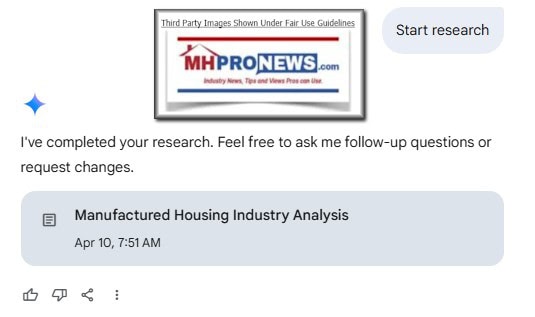
24) Additional insights follow from linked reports. ##

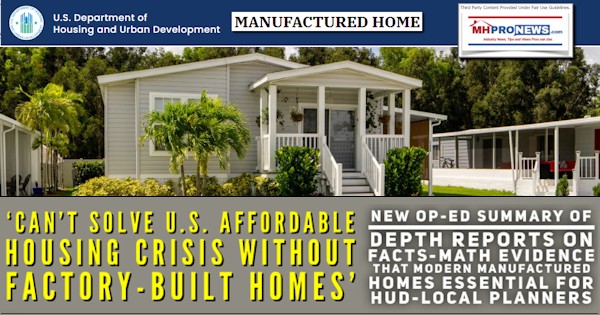
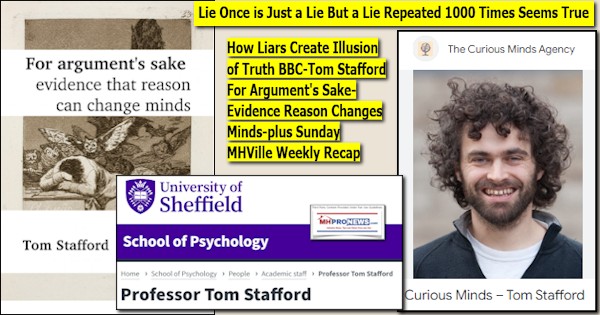
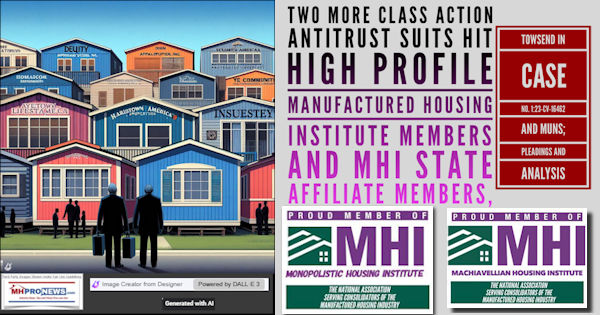
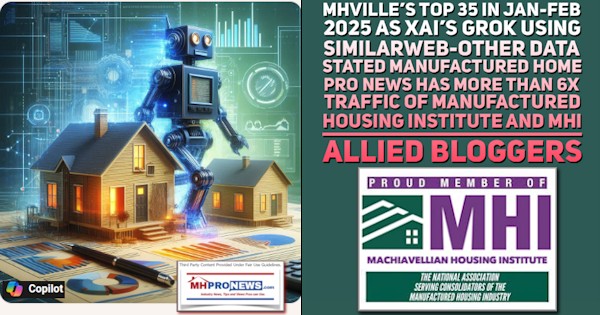
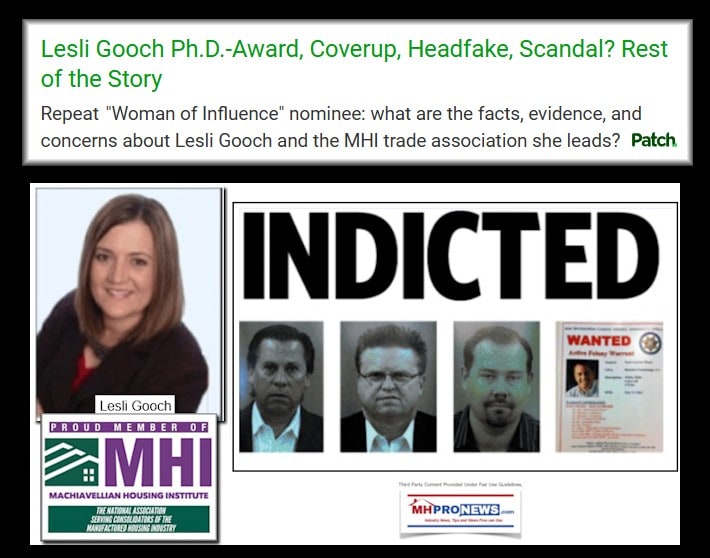

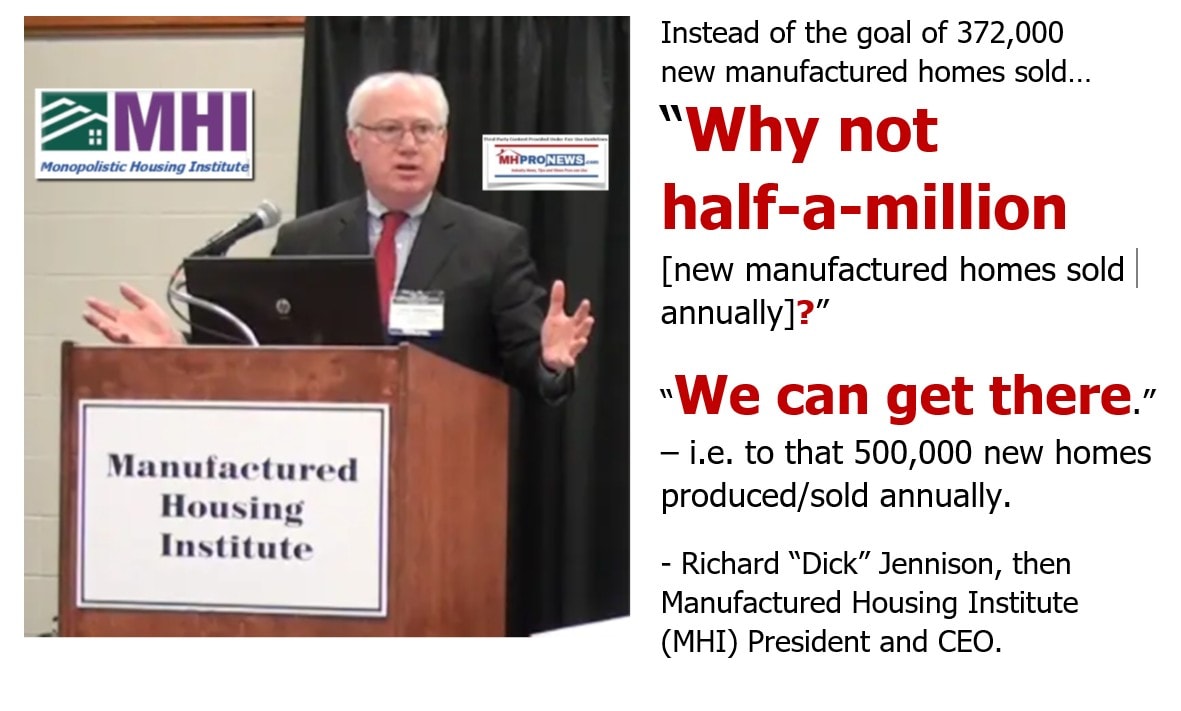

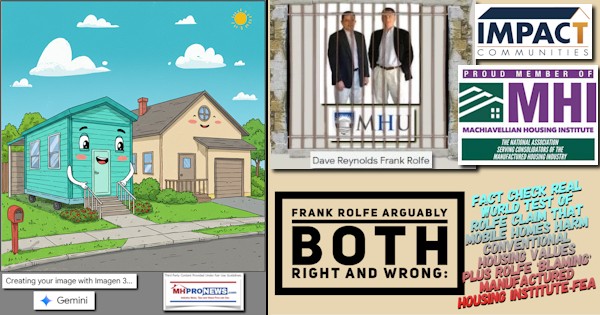
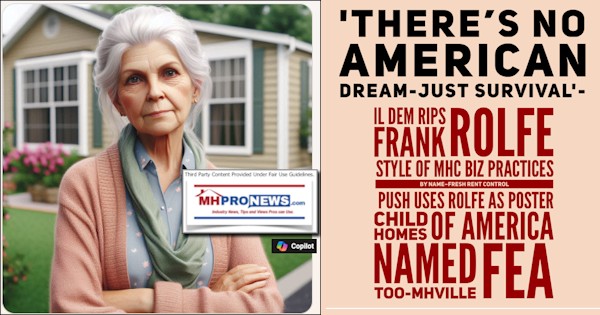
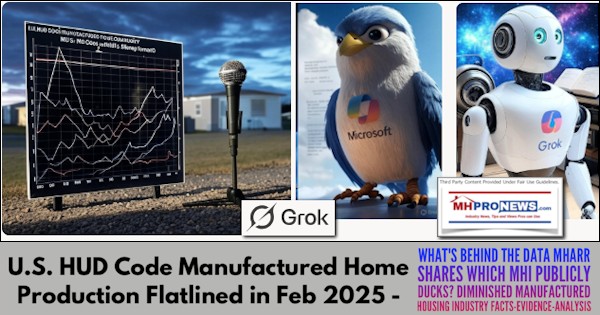
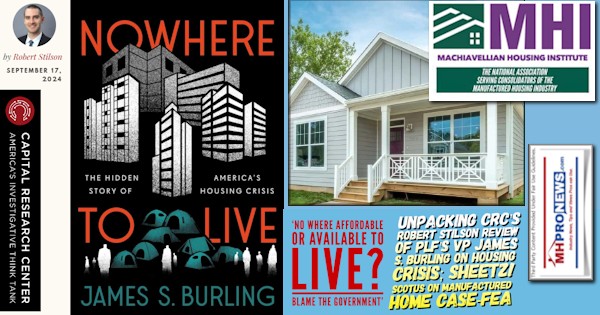
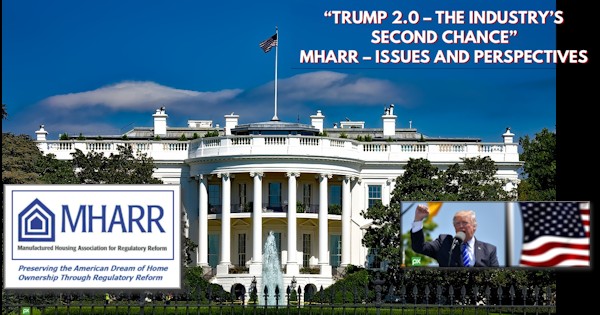
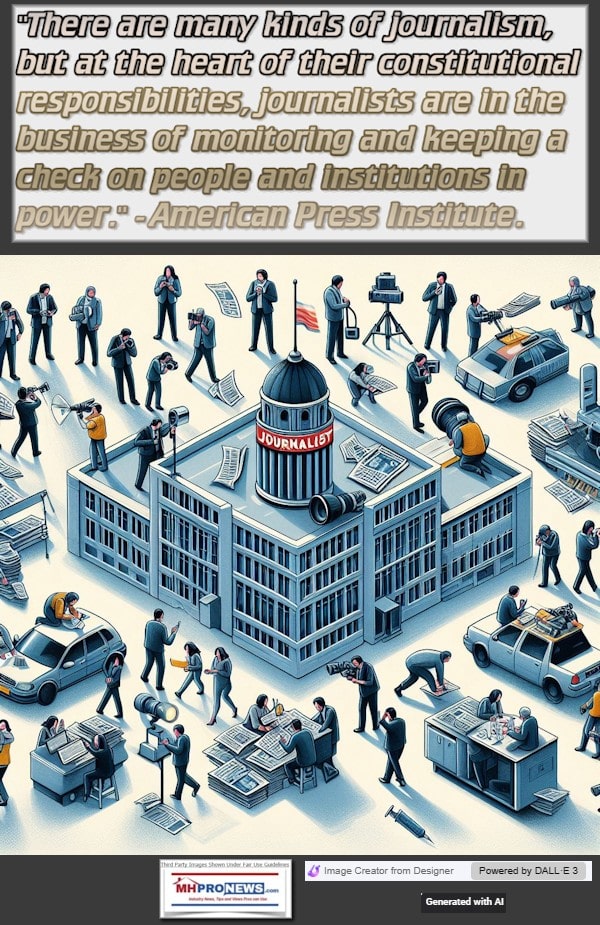

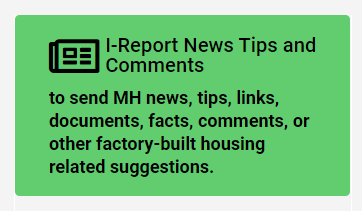
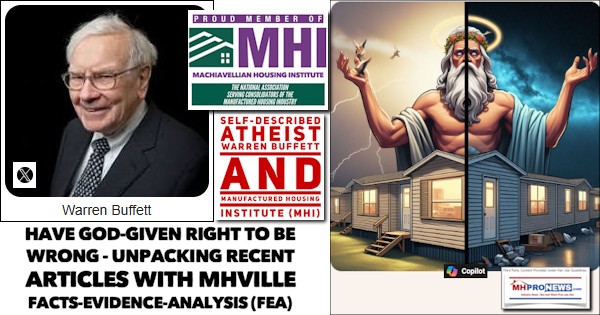

Again, our thanks to free email subscribers and all readers like you, as well as our tipsters/sources, sponsors and God for making and keeping us the runaway number one source for authentic “News through the lens of manufactured homes and factory-built housing” © where “We Provide, You Decide.” © ## (Affordable housing, manufactured homes, reports, fact-checks, analysis, and commentary. Third-party images or content are provided under fair use guidelines for media.) See Related Reports, further below. Text/image boxes often are hot-linked to other reports that can be access by clicking on them.)
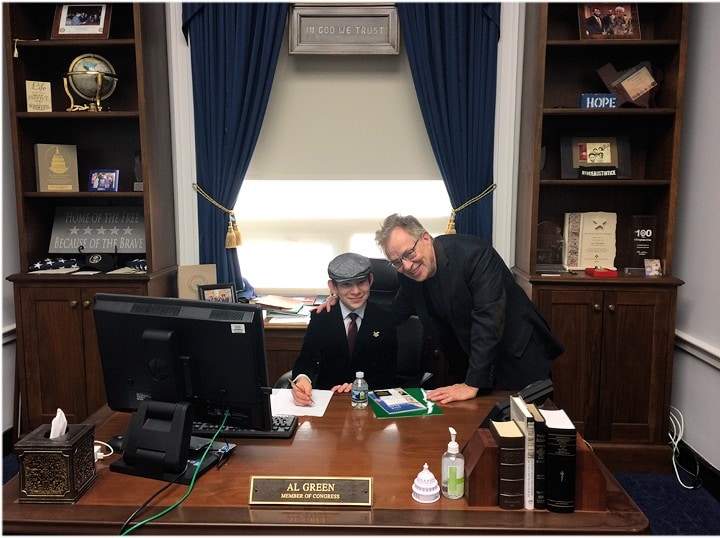
By L.A. “Tony” Kovach – for MHProNews.com.
Tony earned a journalism scholarship and earned numerous awards in history and in manufactured housing.
For example, he earned the prestigious Lottinville Award in history from the University of Oklahoma, where he studied history and business management. He’s a managing member and co-founder of LifeStyle Factory Homes, LLC, the parent company to MHProNews, and MHLivingNews.com.
This article reflects the LLC’s and/or the writer’s position and may or may not reflect the views of sponsors or supporters.
Connect on LinkedIn: http://www.linkedin.com/in/latonykovach
Related References:
The text/image boxes below are linked to other reports, which can be accessed by clicking on them.’
